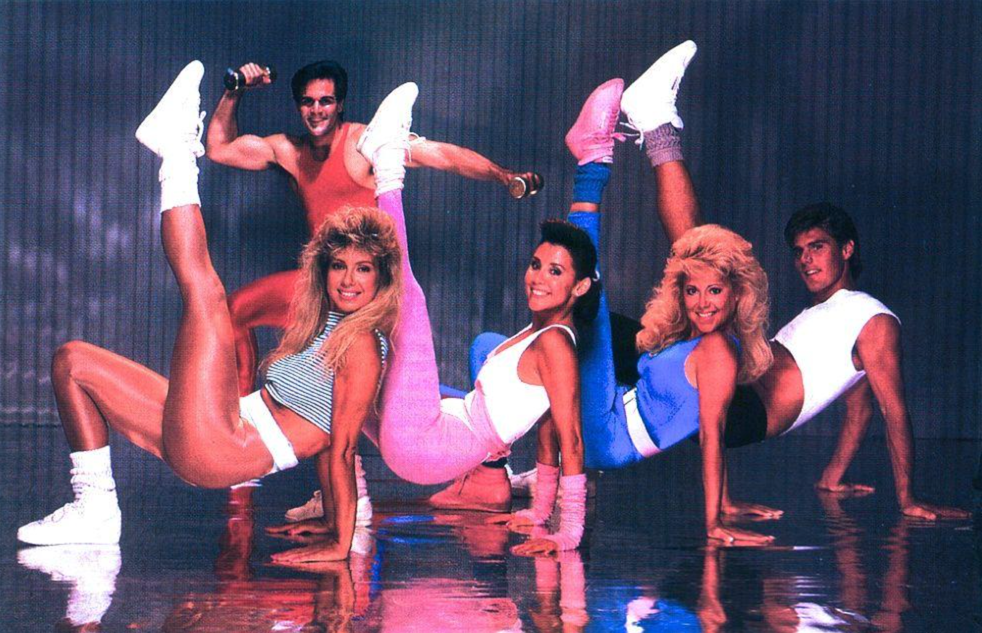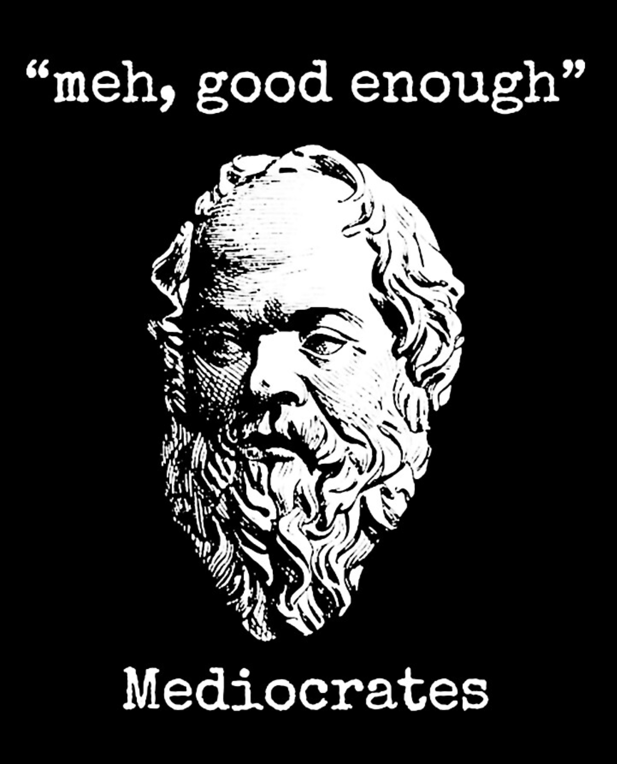Subsections of Nutrition
Start Imperfectly
We must undergo a hard winter training and not rush into things for which we haven’t prepared.
– Epictetus
Welcome to the first day of the challenge!
Today’s topic is how to get everything together to crush this challenge. Here’s a list of things you’ll need:
It’s not a typo; you don’t need a single thing to crush this challenge. We all have reasons why this isn’t a good time to start. I don’t even need to list the reasons because I know you’re mentally rehearsing them as you read this.


Focus on these words for just a minute. Things will never be perfect; start anyway. The next 45 days will pass regardless.
We can’t do this life thing halfheartedly. There’s no time off. There aren’t even weekends. We are always preparing for what life might throw at us– and when it does, we’re ready and don’t stop until we’ve handled it.
– Ryan Holiday, The Daily Stoic
Commit to completing today’s tasks and nothing more. Don’t worry about yesterday. Don’t fret about tomorrow. Focus on today because, in reality, that’s all you have. Once those tasks are done, you’ve won the day. The rest of the day is yours to do as you wish, and you can enjoy it knowing you’ve made progress on taking care of yourself in all the critical areas of your life. You did this for you.
Take one step
Rather than allowing yourself to get overwhelmed and not do anything, take one step.
A journey of 1,000 miles begins with the first step.
—Unknown
The great thing is it doesn’t matter what that step is:
- Increase your daily protein intake
- Restrict eating to only 8 hours per day (intermittent fasting)
- Logging your food in My Fitness Pal or a spreadsheet
- Planning your meals each day in advance
You don’t have to have the perfect plan to get started
We often fail to begin a journey because we don’t feel we have all the answers.
Start anyway
Perhaps you really like breakfast but have read that intermittent fasting works best if you delay your first meal as long as possible.
Fine.
Have breakfast.
It doesn’t have to be a perfect plan, but start if it’s better than what you’re doing now. Measure and adjust as needed.
Today’s tasks
Here are your tasks for the day:
- Drink 1 gallon of water
- Workout for 45 minutes
- Read ten pages from your book
Once those tasks are done, go to this website and check them off. Remember, the website will be locked at the end of the day, so be sure to complete this before bed.
How to measure success
I hear what you’re saying: ” How do I know if this is working?!?!” After all, you’ve got to see the success of this plan, or you aren’t going to stick with it.
First of all, throw away your scale.
Ok, you don’t really have to throw it away. It’s an essential tool. But, if this is
- your first real effort to control your health, fitness, and nutrition without going on a diet
- a dramatic change from your previous eating habits (hint: it is)
Give your scale a break.
Let’s call your weight out for what it is:
weight: (n) the force acting on an object due to gravity
So if you need detailed, daily calculations related to the effects of gravity, by all means, use your scale daily. For everyone else:
Your body will need some time to accept that things are changing!
You may not see a significant decrease in weight right away, but rest assured, changes are happening to your body. It’s learning to live on less carbs. It’s learning to use protein as fuel. It’s learning to turn fat into fuel. Let it have some time to adjust before stepping back on that scale.
Fix your belt!
What? What happened to this belt? Actually, nothing. As your body starts to become a lean, mean, calorie-burning machine, your body composition will change. Clothes will start to become baggy. You’re going to have to cinch up that belt a notch. In due time, you’ll probably have to go shopping for a whole new wardrobe (I know, I know… it’s the price to pay for being sexy!).
So long afternoon crash!
Look for other signs of success, like that dreaded afternoon crash you used to get. You know, the one that had you heading to Starbucks for your afternoon caffeine fix? You’ll see it disappear. When you fuel your body right, you’ll have plenty of energy to power through the day without needing caffeine, 5-hour energy drinks, or other energy supplements to stay awake all day.
Restful sleep
Your body is meant to sleep and sleep well. You’ll find that sleep comes naturally once you stop pumping it full of junk food. It’s deep and restful. It’s refreshing.
But what if…
So when should you expect to see these miracles of nature? The first week may be rough. The second week should be better. Give it the full 45 days to start seeing the effects above. If you don’t see results after that don’t quit. Adjust.
Identify what isn’t working.
Are you hitting your macro ratio consistently? If not, fix that!
Are you hungry all the time? Try increasing your protein (and remember to adjust your carbs and fat to balance everything out).
Are you hungry earlier or later in the day? Try shortening your fasting window to allow more time to eat during the day.
When can I get back on the scale?
At the end of the challenge. No sooner. The only reason to step back on a scale during this challenge is to satisfy that urge to berate yourself for a perceived lack of progress mentally. If you are feeling great, your clothes are getting baggy, you are sleeping better, and you feel the need to find something negative to beat yourself up over, then jump on that scale.
A more accurate number…
Weight alone doesn’t give an accurate picture of your health. To get a complete picture, you must evaluate weight, body mass index (BMI), and body fat percentage.
We’ve already established that weight is the pull of gravity on your body. But what makes up that weight? Is it fat? Water? Muscle? Did Aliens leave a large, heavy object in your body during your last abduction? 🤷♂️ The answer to that question lies in the other two numbers.
BMI is a measure of body fat based on height and weight. It is used as an indicator of your health status and disease risk. It doesn’t tell you how much of your body is muscle mass and tissue vs. fat but it has a lot of research behind it to determine your health risk.
BMI categories are as follows:
Underweight <= 18.5
Normal 18.5 - 25
Overweight 25 - 30
Obese 30 and over
Body fat percentage is a measure of fitness level because it is the only body measurement that calculates body composition without regard to height and weight. I.e., “how much of your body is fat vs. muscle.” Even if your weight isn’t changing, you can see big swings in this number as you lose fat and add muscle, and this is precisely why we avoid the scale daily or weekly. This number changes slowly, but change is good.
Essential fat: Women 10 - 13%, Men 2 - 5%
Athletic: Women 14 - 20%, Men 6 - 13%
Fitness: Women 21 - 24%, Men 14 - 17%
Average: Women 25 - 31%, Men 18 - 24%
Obese: Women >32%, Men >25%
To learn about the different methods for calculating BMI and Body Fat Percentage, including how you can calculate it yourself, see: Body Mass Index
and Body Fat Percentage
Today’s Tasks
Don’t forget to complete today’s tasks for the challenge.
- Drink 1 gallon of water
- Workout for 45 minutes
- Read ten pages from your book
Once completed, be sure to head over to the tracking site and mark them as completed to track your progress for the challenge.
Calories, macros, and why they matter
Brace yourself; today’s topic is a long one with a ton of information in it. It’s good stuff to know, so spending 10 minutes reading this can change how you think about food and nutrition for the rest of your life.
Definition of a Calorie
calorie (noun)
The energy needed to raise the temperature of 1 gram of water by 1 degree Celsius
Well, we got that out of the way! SCIENCE!
No more to say, right? It’s obvious what a calorie is and how/why it’s used to measure your food intake.
Ok, maybe not…
Let’s elaborate a bit.
A calorie is the amount of energy required to raise 1 gram of water by 1 degree. Think of it this way:
You have one gram of water. How much gasoline would you need to light on fire to raise the water temperature by one degree?
Not much, right? This is why food is actually measured in kilocalories or kcal, abbreviated as C even though we still refer to it as a calorie. Science, right?
Your body requires energy to function. You get this energy from food, which in turn gets broken down into the components your body can convert into energy. I won’t go much deeper than that- it’s irrelevant. Just trust me when I say ” You eat food. That food turns to energy.” To have a conversation with someone about how much energy they are consuming (i.e., food) vs. how much energy they are using, we need a standard of measure. It’s the Calorie.
An eight oz. steak has roughly 600 Calories (It actually varies, depending on the quality and cut of the steak, but you get the idea.). Using our definition of a calorie, that’s enough energy to raise 600,000 grams (158 gallons) of water by 1 degree. That’s a lot of energy! Now think about this: you eat much more than a single eight oz. steak daily: that indicates how much energy your body needs to function.
Your body needs energy for many things:
- Your heart burns energy to keep the blood pumping
- Your lungs burn energy to pull oxygen from the air you breathe into the bloodstream
- Your muscles use energy to move
- Your brain burns energy to control the body and for thinking
- Even the process of breaking food into energy requires energy
Here’s a pivotal point to understand: when you put more energy into your body (by eating more food) than your body burns as energy, it gets stored as fat! Mystery solved, eat fewer calories, right?
Not so fast, Sherlock.
Think back to our definition of a calorie: the amount of energy required to raise water temperature. Now consider the different ways we can do this:
To help illustrate the point, let’s consider raising the temperature of a bucket of water. Now let’s pour gasoline underneath our bucket and toss a match on it.
What happened?
If you’re like me, you’ve already done this experiment many times as a kid, and you know the gasoline went up in flames immediately (luckily, before your parents discovered your little experiment). But what happened to our water? Not much, right? The gasoline burned too fast to impact the bucket of water.
So what if we used a nice, solid hunk of wood? If we get that hunk of wood burning (a hunka hunka burnin’ wood, as Elvis would say), it will burn for a long time. Long enough to raise the temperature of the water in the bucket above it.
We used the same amount of energy in both examples, but one had the desired effect, and one did not.
Let me bring this home to you and your goal now:
The same is true for the types of energy you put into your body.
Carbs = gasoline
Fats and protein = wood
When we eat carbs, we get a big gasoline-style explosion. But if equal energy demand isn’t present in our body, those carbs get stored as fat. When we fill up on healthy fats and proteins (you’ll learn what those are later), we get a nice, slow-burning furnace to fuel the engine of our body.
For this reason alone, the source of your calories is more important than the number of calories you consume!
There’s another factor at play here too, and it concerns our body’s chemistry. When we eat, we get a big surge of energy. When this energy starts to fade, our body receives a signal that energy levels are going down. We interpret this as hunger.
So we eat again.
Suppose we’re using gasoline as our fuel source (i.e., carbs). In that case, we continuously pour gasoline into our bodies to keep the energy levels high, even though we didn’t do anything productive with the gasoline in the first place.
So now I hope you can see that where your food energy comes from can impact your energy levels and weight loss efforts. But what to do? The answer lies in balancing carbs, fats, and proteins, and that is where we head next.
Definition of a Macro
Macronutrient (noun)
a substance required in relatively large amounts by living organisms, in particular
- a type of food (e.g., fat, protein, carbohydrate) required in large quantities in the human diet
- a chemical element (e.g., potassium, magnesium, calcium) required in large amounts for plant growth and development
Assuming that you aren’t a plant, we can ignore the last part of that definition and focus on the part relating to humans.
Our foods are categorized into different macronutrients: carbs, fats, and proteins. This categorization is based on how the food is broken down and used by your body. We’ll dig into that in a minute. The critical thing to know about them is that we need all three macronutrients in our diet, and we need them in the right amounts to meet our energy requirements.
Almost all food contains some amount of all three macronutrients. We categorize each food by its primary macronutrient. A potato, for example, has 70g of carbs, 7g of protein, and 2g of fat. Since the primary macronutrient is carbs, it’s considered a carb source.
Review the three macronutrients and learn how and why they are essential.
Proteins
Proteins are made of amino acids, commonly called the ” building blocks of the body”. There are 20 amino acids in your body, nine of which cannot be manufactured by your body. The only way to get them is to eat them, thus, protein to the rescue. Protein helps form and maintain muscle mass and provides energy for our muscles and brain. Protein is considered especially important for its role in building lean muscle mass and is known for its satiety effect, meaning when you eat protein, you feel fuller and longer. This is primarily due to the amount of time it takes to break protein down in your body and turn it into energy (think of our hunk of wood from above). The part you likely care about is that it suppresses your appetite.
You’ll find many different recommendations on the amount of protein needed daily. Most answers range from .7 - 1 g of protein per pound of body weight. That should be sufficient unless you are specifically focused on bulking up and gaining muscle. Rather than debate the merits of varying protein quantities, we will let our macro ratio determine the amount. You’ll learn how to do that tomorrow.
Sources of protein include meat, fish, dairy, and some beans.
Fats


Those of us who grew up more than a decade (or two) ago were taught that fat was the evil enemy. The root cause of your weight loss struggles. The Homer Simpson to your Frank Grimes.
Nothing could be further from the truth.
Not all fats are created equal. Deep-fried foods, vegetable oils, and highly refined fats known as trans fats (found in margarine, vegetable shortening, baked goods, and processed snack foods) are indeed the enemy.
Healthy fats, such as avocados, nuts, fish, and meat, are essential to providing energy, making you feel full after eating and regulating body functions.
Healthy fats regulate hormone production. They help you control your body temperature. Fats are required for absorption of fat-soluble vitamins (like Vitamin D). Fat is also the primary energy source for your most valuable asset: your brain!
When adopting a low-carb diet, fats are crucial in ensuring you get enough calories in your diet and minimizing the effects of feeling hungry (because they don’t come with the sugar high, followed by the sugar crash associated with carbs).
Eating fat does not make you fat
Contrary to our knowledge in decades past, eating healthy fats does not raise your cholesterol levels; it’s just the opposite. A diet comprised of healthy fats can help increase levels of “good” cholesterol (HDL) while lowering “bad” cholesterol (LDL).
Carbs
Carbs are the tricky part of this equation, so let me preface this section:
You will never struggle to get your daily requirement of carbs.
Seriously, they are in everything.
But before we banish them to Mordor alongside Frodo’s ring, let’s put them in perspective. Carbs are broken down into glucose, which can easily be used for energy (think of them like starting a fire with gasoline) or, if you don’t currently need them- they are stored in the body for fat. (Notice that? Fat isn’t stored in your body as fat; carbs are!)
Carbs are the body’s #1 source of energy. But don’t mistake that statement: it’s not a free reign to pound away some sugary snack just because you worked out this morning at the gym.


Let me bust a few more myths (that I learned the hard way) while we’re here:
- You don’t need to replenish your carb stores after hitting the gym.
- You don’t need to carb load for a 5k tomorrow (or a 10k, or a marathon).
- You don’t need to search for carbs to get fiber in your diet.
- Net carbs are marketing tactics.
If you follow the methods laid out here, I promise you will get plenty of carbs in your diet, and while you won’t be eating whole-grain pop-tarts, you won’t miss them either.
Why Macros Matter
Cool story, bro. Who cares?
Most people focus on a specific calorie goal and expect unrealistic results. The truth is, where your calories come from is more important than the number. You’ll soon see how focusing on macros makes calorie counting irrelevant or necessary, with the added bonus of feeling better and hitting your goals.
Let’s start with an example:
Say your daily calorie intake should be 1,500 calories. You measure against this number, hoping to lose weight and body fat, without regard for where the calories come from.
Meal Plan #1
1 Milky Way Candy Bar (240C)
1 Vanilla Pudding Cup (240C)
1 Bag of M&Ms (240C)
1 Quarter Pounder with Cheese (520C)
1 20 oz. Pepsi (250C)
Total: 1,490 calories
Meal Plan #2
1 6 oz. Chicken Breast (335C)
2 T Hummus (70C)
1 C Cottage Cheese (200C)
Salad with spinach, bell peppers, tomatoes, and balsamic dressing (250C)
1 C Greek Yogurt (220C)
1/4 C Dark Chocolate Granola (170C)
1 Protein Shake (250C)
Total: 1,495 calories
Both meal plans hit your daily calorie intake goals. After 30 days of this plan, which plan do you think is likely to produce results?
Hopefully you see the flaws in sticking to Meal Plan #1.
Let’s break it down to understand why.
Meal Plan #1 has the correct amount of calories, but it’s loaded with sugar. Eating this meal leaves you full but generates a massive spike in your blood sugar levels. An hour later, your blood sugar levels will start to decrease, signaling to your brain that you need to eat to replenish your depleting energy level. You’ll never be able to eat only this in a given day. You’ll be hungry and irritable and go in search of more food. As a result, you’ll overeat your daily caloric requirements (not to mention the severe lack of vitamins and nutrients in this meal plan).
Meal Plan #2 has the same number of calories but with huge differences in the way your body will respond. The chicken provides protein, which will be used by your body to repair damaged muscle fibers and build new muscle. It’s slower to digest, so you’ll feel fuller and more satisfied for longer. The same is true for the cottage cheese and protein shake (sort of). The Greek yogurt brings a mix of carbs, fat, and protein. The carbs will provide quick, accessible energy. The fat will be broken down slowly, preventing hunger from striking for hours. The salad provides fiber, vitamins, and nutrients, and the dressing is another source of fat for your energy reserves. I can promise you, after eating this throughout the day, you will not be hungry. In addition to not being hungry, you will provide your body with plenty of protein, fats, and carbs to maintain a healthy lifestyle that promotes sensible eating and sustained weight management.
Using these meal plans as an example (combined with what you’ll learn tomorrow), it becomes clearer that not all calories are created equal. The source of the calories becomes more critical than the actual number of calories.
There is some hidden magic here, too. By choosing our source of calories, we can manipulate how our body responds. Take a look at this:
- Protein: 4 calories per gram
- Carbs: 4 calories per gram
- Fats: 9 calories per gram
Remember that carbs are like gasoline to a fire: it burns quickly and is gone. Protein and fats require much more energy to break down. That means that our digestive system is busy working for longer, leading our brain to believe that there must be plenty of energy available (after all, those guys down in the GI Tract are still working hard). By stacking our diet in favor of protein and fats, we can provide our body with the same amount of calories but at a much more controlled burn rate.
So, we can hit our 1,500-calorie goal with 375 g of carbs, 375 g of protein, or 167 g of fats with significantly different results on our bodies.
The exact ratio of carbs, fats, and protein matters, and knowing how much of each you need is precisely what we’ll cover next.
Today’s Tasks
Don’t forget to complete today’s tasks for the challenge.
- Drink 1 gallon of water
- Workout for 45 minutes
- Read ten pages from your book
Once completed, be sure to head over to the tracking site and mark them as completed to track your progress for the challenge.
How Many Calories Should I Eat?
Now that we know what calories and macros are, and the role they play in healthy eating, the next question becomes “how many should I be eating?” There is a lot of misinformation on this topic, but we can come up with some sensible guidelines. The important thing to remember is that the answer doesn’t really matter. You make an educated guess, try it, and adjust. Because you are tracking and measuring, the right answer reveals itself to you.
To get your starting number, use the Mayo Clinic calorie calculator. There are many similar websites out there, I like this one because sites like the Mayo Clinic use evidence-based research in their published articles. Other sites can and will skew these numbers to align with the marketing of the product they are trying to sell you. (Pro-tip: in the health and fitness industry, always ask yourself what the person providing the information is trying to sell you.)
Lean Muscle Mass and BMI
Next, you need to determine your nutrition goal: build muscle? maintain? lose fat? You can only pick one. If you try to juggle more than one, you will sabotage your efforts. You may have some initial thoughts on which one, but I recommend letting your body tell you. To do that, you need to know your Body Fat Percentage.
If you know your BMI, you can approximate your body fat percentage with the following formula:
(1.39 x BMI) + (0.16 x age) - (10.34 x gender) - 9
gender: 0 for female, 1 for male
If you don’t know your BMI, you can approximate your body fat percentage by entering your measurements here.
So now you’ve got a number. What to do with it? If your number is greater than 30 (for women) or 24 (for men), I strongly recommend your priority is fat loss. Subtract 10% from the calorie intake you calculated above to create a calorie deficit, and stick with that until you are down to 20% (women) or 13% (men). Now let’s figure out what those calories should be made of…
Macro Profiles
Yesterday, you learned not all calories are created equal. Let’s talk about macro profiles, why they are essential, and how they provide a better way of managing your goals. This is true regardless of your goals. It works for weight loss. It works for muscle gain. It works for maintenance.
Let’s start by defining what a macro profile is.
It’s the ratio of carbs:protein: fats that make up your diet. For example, a macro profile might say that 30% of your calories come from carbs. Another 40% comes from protein, and the remaining 30% comes from fats. Notice that I didn’t mention how many calories you need! This is a ratio, so it’s going to work the same whether you need 1,500 calories per day or 2,500.
Here’s where the magic happens (along with a little math):
Assume that you’re daily calorie intake is 2,000 calories(fn) and you are using the 30/40/30 carbs/protein/fat macro profile.
Using a little math, we can multiply 2000 x 30% to learn that we need 600 calories per day from carbs, 800 calories per day from protein (because 2000 x 40% = 800) and 600 calories from fat (because 2000 x 30% = 600).
We can validate our math: 600 calories from carbs + 800 calories from protein + 600 calories from fat = 2000 calories
Now we need one more piece of information to make this work:
Carbs contain four calories per gram.
Six hundred calories divided by four calories per gram equals 150 grams of carbs daily.
Protein contains four calories per gram.
Eight hundred calories divided by four calories per gram equals 200 grams of protein daily.
Fat contains nine calories per gram.
Six hundred calories divided by nine calories per gram equals 67 grams of fat daily.
So all of the information above can be distilled to:
150 g carbs
200 g protein
67 g fats
With those three numbers, you never have to count another calorie again. Eating 150g of carbs, 200g of protein, and 67g of fats can never add up to anything besides 2,000 calories.
What makes this so incredibly important is you are now controlling the source of your calories, not just the number. This means you won’t binge on 2,000 calories of carbs and alcohol and sabotage your goals!
The 30/40/30 ratio mentioned above is one example of a macronutrient ratio. There are other popular ones as well. The right macro ratio for you depends. No one can tell you what it is.
I’m going to take a side note for a minute here. Consider this our heart-to-heart conversation. I’m going to be brutally honest. It may not be the most pleasing news, but you need to hear it from someone, and since you’re reading this, that someone gets to be me.
You are going to have to choose your macro ratio. No one else can choose it for you: you have to own this. If you let someone else choose it for you, it’s still your choice to accept their answer and you own the consequences.
If you choose not to decide, you still have made a choice.
Rush, Freewill
You may choose the wrong answer the first time. That’s ok. When you decide it’s not right for you based on measured results, you are not going to throw your hands in the air and give up. You will make a new choice and measure the results. If the results aren’t what you want, you’ll choose again and measure the results. And you will keep repeating this process until you get it right.
Many people are going to try and convince you they have the answer. Their fail-proof diet/plan/formula/technique or whatever is the hope and salvation you’ve been looking for. When these people appear, they are trying to sell you something.
You must own this because you are the only “you” you’ve got!
Ok. That’s over. I feel better.
Back to macro profiles: a lot of it concerns your body type, which your ancestry may significantly impact. This website does a really great job of breaking it down. It’s essential when looking at the chart to look at who you really are not who you wish you were.
The three common ratios shown there are:
55/25/20 (carbs/protein/fat): Ectomorph- people with long, skinny limbs who are naturally thinner.
40/30/30 (carbs/protein/fat): Mesomorph- typically identified as naturally muscular and athletic individuals.
25/35/40 (carbs/protein/fat): Endomorph- naturally broad and thick individuals
Some other common ratios include:
50/30/20 (carbs/protein/fat): This one is called “moderate,” but seriously, that’s a lot of carbs.
40/30/30 (carbs/protein/fat): Also seen above, this can sometimes be called the Zone Diet.
25/45/30 (carbs/protein/fat): This ratio is known as low carb. It’s interesting to point out that many low-carb fads and diets fail to hit this ratio.
10/15/75 (carbs/protein/fat): This is the Keto (or Ketogenic) ratio. You may have heard the term “keto" before. As you can see, it uses an extremely high-fat content to force the body into generating its ketones for energy. This is extremely interesting and has shown some pretty impressive results for cancer patients, but this is not to be taken lightly. This is tough to follow, and the penalties are harsh for “cheat days.” Unless you have successfully followed a macro-profile-based meal plan before, I do not recommend this without the supervision and guidance of a professional, licensed nutritionist.
We covered a lot, so I want to highlight the takeaways.
- Counting macros frees you from counting calories while providing your body with the “stuff” you need to mold it how you want it.
- Hitting your macros guarantees you won’t exceed your calorie goals, so there is no point in counting calories.
- The correct macro ratio may require some trial and error on your part but even guessing wrong is going to put you closer to your goal than you are now.
Tomorrow we’ll look at different meal plans and learn some ways to evaluate which meal plan is right for you, but for now:
Today’s Tasks
Don’t forget to complete today’s tasks for the challenge.
- Drink 1 gallon of water
- Workout for 45 minutes
- Read ten pages from your book
Once completed, be sure to head over to the tracking site and mark them as completed to track your progress for the challenge.
Choosing A Meal Plan
Paleo, vegan, whole food, keto, Mediterranean, the list goes on. Which one should you choose? There are so many options; getting started’s almost too overwhelming.
Here’s the magic secret no one wants you to know: you don’t have to choose.
Most popular meal plans today are based on marketing, not science. They are all pimped by marketers flaunting amazing before and after pictures, testimonials of people who have turned their lives around and avoided certain death, and pseudo-scientific facts about why this plan is better than the “others.” Somebody queue Tiny Tim; it’s time for his tear-jerking miracle scene. I’ll be over in the corner vomiting.


It’s a miracle; God bless us, everyone!
The truth is: if your “diet” before consisted of 1200-calorie Chipotle burrito bowls, craft beer, and meal replacement shakes, any sensible change is going to produce dramatic results. It’s not because you found the one diet; it’s because you stopped eating like shit.
If you do nothing else…
Fill your plate with foods that closely resemble the plant or animal it came from. (I see you reaching for those marshmallow peeps and chocolate bunnies. Let’s get a little closer than that, m’kay?) Minimize processed foods, and don’t drink your calories.
It’s ok if you want to follow one of those meal plans. I have, and on occasion, still do. They are a great way to get ideas for new recipes and minimize information overload for eating. Understand meal plans for what they are: a recipe collection, not a holy grail to healthy eating. Below, I’ll list some of the popular plans, and if one sounds like something you’d like to try, by all means, go for it. One word of caution: regardless of what the “experts” tell you, count and follow your macros. Marketing sells, but science works.
Paleo
The Paleolithic diet, also known as the Paleo diet, caveman diet, or stone-age diet, consists of foods thought to mirror those eaten by our Paleolithic-era ancestors. It primarily consists of eating meat, fruits, vegetables, nuts, and seeds. The overarching principle is ” If a caveman would eat it, so can I”. I’ve not seen any scientific evidence on the impact of leaving a cheesecake in a caveman’s dwelling. 🤷♂️
Whole 30
The Whole30 diet is similar to paleo but more restrictive. In addition to eliminating sugar, alcohol, grains, legumes, soy, and dairy, Whole30 eliminates natural sweeteners like honey or maple syrup. One benefit of Whole30 is the comprehensive list of foods you can eat. With Paleo, some foods are hotly debated regarding their availability or consumption by actual cavemen. On Whole30, the authors provide a list of foods; nothing else qualifies.
Mediterranean
The Mediterranean diet is inspired by the eating habits of Spain, Italy, and Greece in the 1960s. The principal aspects include olive oil, legumes, fruits, vegetables, fish, cheese, yogurt, and wine.
Keto
The keto or ketogenic diet has been increasingly popular lately. Keto is a high-fat, adequate-protein, low-carb diet that forces the body to burn fats rather than carbs as fuel. Its primary use is for its therapeutic effects in patients with neurological disorders, cancer, and obesity. Let’s be very clear: most people claiming to be on the keto diet are doing low-carb (see below). The critical difference is measuring. The word “keto” actually comes from the word “ketosis,” describing the state the body is in when the liver starts producing ketones, which are then used by the body as fuel. Counting macros is critical to maintaining the keto diet. Failure to track the macro ratio will result in your body falling out of ketosis, thus not producing the desired results. For those on the keto diet for medical reasons, this may include death. Carb selection is also critical. With carbs restricted to low levels, it’s essential that every carb you eat contains the most vitamins and nutrients possible to avoid the effects of malnutrition.
Low Carb
The error-friendly version of Keto, also known as Atkins. Foods high in carbs are restricted and replaced with more fat and protein foods. Typically, this means eliminating sugar and grains from the diet. This diet is actually straightforward to follow, and easy to get your daily intake of vitamins and minerals from fruits and vegetables.
Wrapping Up
Those are just a few of the thousands of diets available. Here’s the thing I want you to take away: you don’t have to choose any of them. If one looks like something you’d like to try, by all means, do so. Measure your protein, fat, and carb intake to avoid overeating and sabotaging your goals. If you decide you don’t like it, switch. As long as you stick to your macro ratio, you can choose any or all of these because you are only changing what foods constitute the source of your macros.
Today’s Tasks
Don’t forget to complete today’s tasks for the challenge.
- Drink 1 gallon of water
- Workout for 45 minutes
- Read ten pages from your book
Once completed, be sure to head over to the tracking site and mark them as completed to track your progress for the challenge. Tomorrow we’ll talk more about the source of our macros when we address What should I eat?
What Should I Eat?
I can hear some of you already; “What?!?! What am I supposed to eat? Do you expect me to eat the same thing every day?!?!?”
Well, yeah…
But hear me out first: you already do.
For a vast majority of us, we eat the same thing over and over: a chicken, a cow, a pig, a fish. I’m willing to bet there is a similar pattern in your selection of fruits and vegetables, too. Ewww. Kale is gross; I’m not eating that. So you stick with iceberg or romaine lettuce, and the only time you switch is when your preferred leafy, green salad staple is currently contaminated with an ecoli outbreak.
It’s not the food; it’s the seasoning
It’s not the chicken that provides variety; it’s the seasoning. Some days you have it with spicy seasoning. Some days it is simmered in a broth. Some days it is dredged in salt and pepper and fired up on the grill. Some days it is scrambled or cooked over-easy.
It’s still a 🐓.
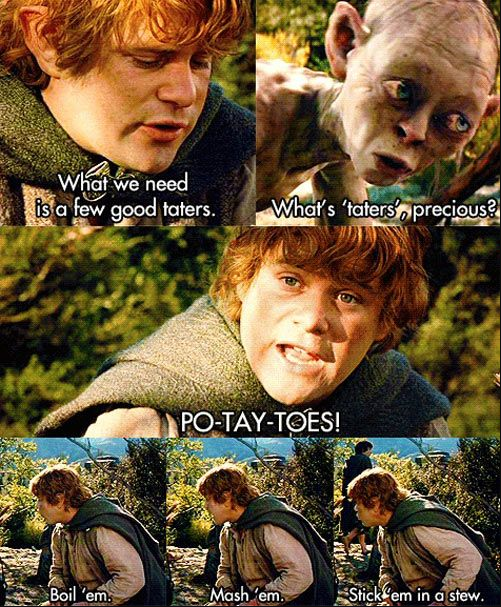

So, if we can agree that you already eat the same thing day after day, but seasoned differently, let’s work with that. According to your macros, how much chicken (beef, pork, or tofu) do you need to meet your intake? Find that number. For the sake of conversation, let’s say it’s 10 oz. You know, if you are eating chicken today as your protein, you need 10 oz of it. What you do to that 10 oz is entirely up to you. Grill it, bake it, stew it, slather it in peppers, or whatever makes you happy.
This is the key to sticking with your nutrition plan long term. Change your mental attitude: food should not be the source of variety in your life. It’s the people with you when you eat. The environment. The situation. Add mixture to other areas of your life: learn to play an instrument, launch a YouTube channel, go to the grocery store without a mask, and make friends with trashy people you can’t introduce to your other friends.
Today’s Tasks
Don’t forget to complete today’s tasks for the challenge.
- Drink 1 gallon of water
- Workout for 45 minutes
- Read ten pages from your book
Once completed, be sure to head over to the tracking site and mark them as completed to track your progress for the challenge. Tomorrow we will combine everything we’ve learned to create your meal plan. We’re not done talking about nutrition yet, though; just implementing what we’ve learned so far.
Create Your Meal Plan
We’ve spent the last week learning about the fundamentals of nutrition: calories, macros, calorie intake, and meal plans. Now it’s time to take action. Today you are going to create your meal plan. Once created, this is the meal plan you will follow for the remainder of the challenge.
Tips
Take some time this morning to decide what meal plan (paleo, whole30, etc.) you will follow, if any. Remember: you have all the knowledge you need to create your own meal plan just by calculating and following your macros.
Plan out a full day of meals that fit that plan. Now look at that day and see how many components of it can be reused.
Consider making a double-sized portion of some meals, and use the extra as a lunch or dinner the next day.
How many items on your list can be changed for variety without adjusting the quantity? I.e., take the 6 oz chicken breast for dinner: use sugar-free BBQ sauce one night, grill a second night, and slice into a garden salad a 3rd night. It’s the exact macros every time but used differently to prevent boredom.
Plan as many meals in advance as possible. This minimizes on-the-fly decisions (which always turn out bad).
Meal-prepping is your friend. Use weekends or days off to cook ahead of time so when meal time comes during the week, and you’re one step ahead of the game with fresh, ready-to-eat meals already prepared that support your nutritional goals.
Today’s Tasks
Don’t forget to complete today’s tasks for the challenge. Today we add a new task to your list: sticking to your meal plan.
- Drink 1 gallon of water
- Workout for 45 minutes
- Read 10 pages from your book
- Stick to your meal plan
Once completed, be sure to head over to the tracking site and mark them as completed to track your progress for the challenge. Tomorrow we’ll learn about using tools like MyFitnessPal to track your macros and creating recipes to make tracking easier.
Using MyFitnessPal
If you don’t measure it, you can’t change it. While valid for most areas of life, today we will discuss its significance in changing your nutritional intake.
If you haven’t already done so, download and install the MyFitnessPal app for your device. It doesn’t matter if you are using Android or iOS. The screens may differ in layout, but the functionality is the same. Create a user account and sign in. There is no need to upgrade to the paid plan; everything I show you in this chapter will be done using the free plan. (There are some really nice features in the paid version, but for now, let’s master the basics).
When you open the app, you will click the button on the bottom that says “Diary.”
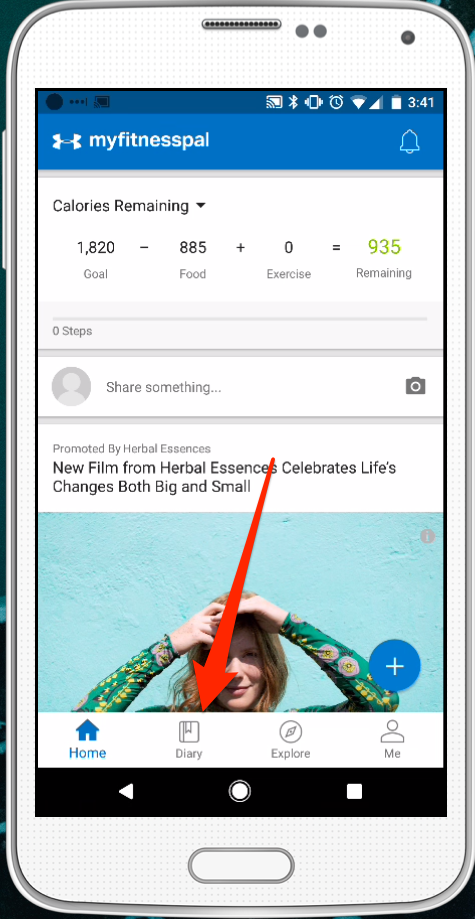

Doing so will open your daily food log, which happens to be entirely blank at this point.
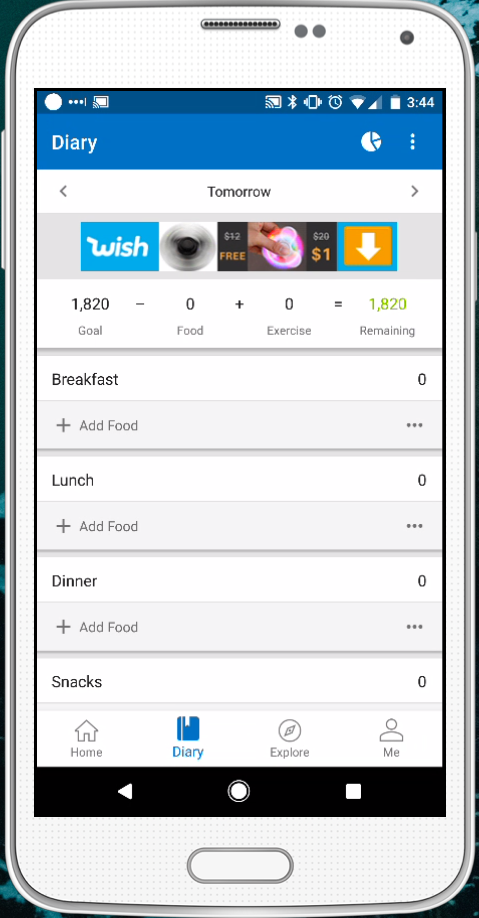

Let’s add some food to it. I’m going to add my dinner from last night as an example.
When you hit the button for additional food, it shows a list of things you’ve recently added. This means the more you use the app, the easier it will become. My favorite feature is the “multi-add” button. Clicking it allows me to check the items I’ve eaten recently and add them.
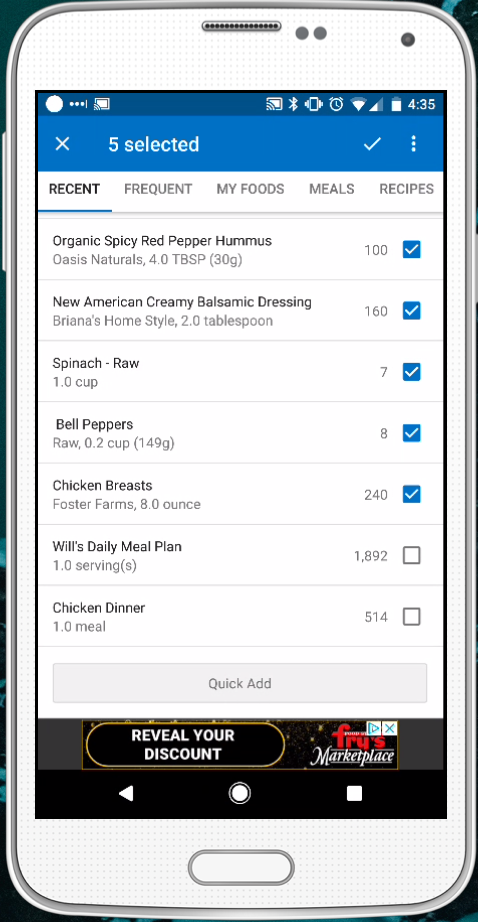

If you are just getting started with MyFitnessPal, your “Recently eaten” items will be blank. You have two options to fix that:
- type in the search box, find the item you are looking for, and add it
- Scan the barcode
Option #2 is much simpler, and when you start looking, you’ll be amazed at how much of the food you eat has a barcode. The great thing about using the barcode is that it adds the exact brand you are eating. This makes your results more accurate as foods vary from brand to brand.
To use the barcode scanner, click the barcode icon in the app:
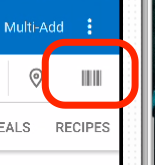

Then find the barcode on your food and scan away!
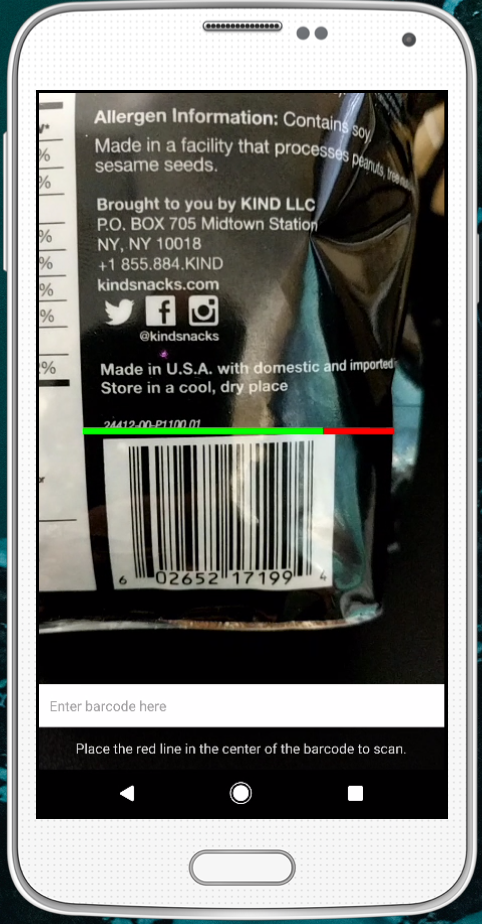

If all goes well, MyFitnessPal will load the nutritional details for your scanned item. You can adjust the quantity and serving size, then save it to your food diary.
Over the last week, we’ve been doing a lot of math. We’ve calculated macros, calories, and ratios. Now, using MyFitnessPal, I can let my phone do all the work!
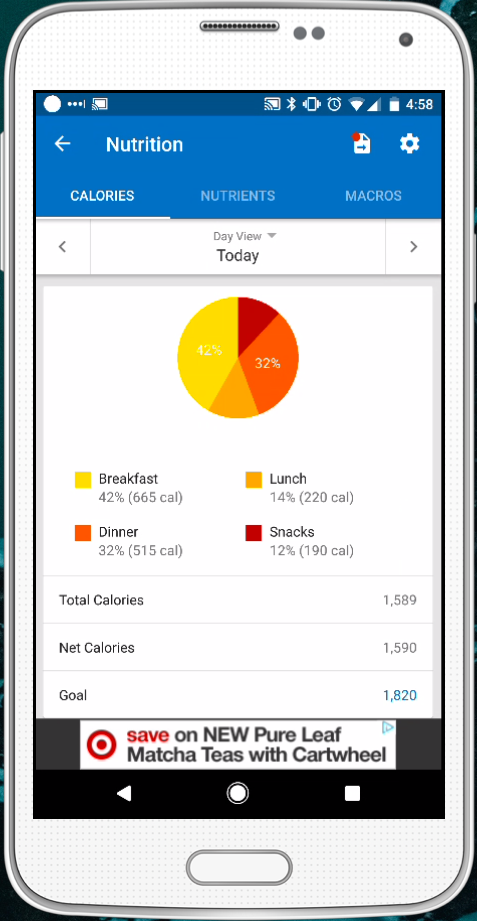

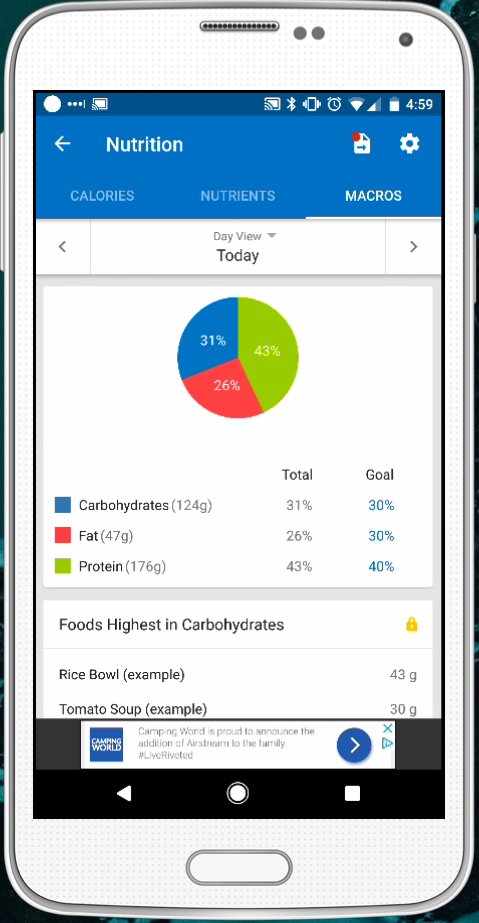

You’ll notice in the macro screenshot that I’ve even told MyFitnessPal about my macro ratios. As a result, MyFitnessPal shows me how close I am to my targets. In the paid version of the app, you can access even more detailed information and alerts.
Combining Foods into Recipes, Recipes into Meals, and Meals into a Daily Food Log
Now that we know how to add individual food items to our diary in MyFitnessPal, it’s time to build upon that knowledge.
For what it’s worth, you’ll notice that I do that often:
- learn a new skill
- learn another skill
- bundle those skills into one task
I learned a technique known as Stacking from Tony Robbins. You use it all the time, and you may not realize it. Think about when you first learned to drive: You had to master the gas pedal. Then you had to figure out how the brake worked. Before long, you needed turn signals (though some appear to have forgotten this tidbit of learning). After a while, you learned to do those all with little effort, in addition to working the heater, a/c, radio, and other accessories. Now you refer to all those individual tasks as driving and rarely consider the individual steps of the overall task.
We’re doing the same thing with eating. You are learning to:
- choose foods
- identify the macros
- adjust quantities to meet your macro ratio
- combine foods to make a meal
- combine meals into a daily food plan
Over time, these skills will become as natural to you as slipping into the driver’s seat and heading to the corner store, with the bonus of eating healthier, feeling better, and nailing those fitness goals!
Saving Ingredients as Meals
Let’s add a sample meal. We’ll convert some individual items into a meal in MyFitnessPal. Suppose you had a dinner consisting of grilled chicken breast, rice, and a side of red grapes.
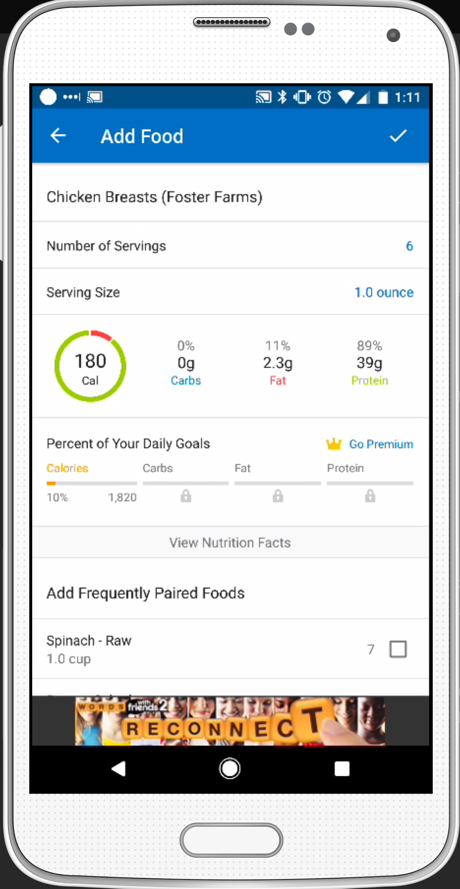

We’ll start by adding the chicken breast.
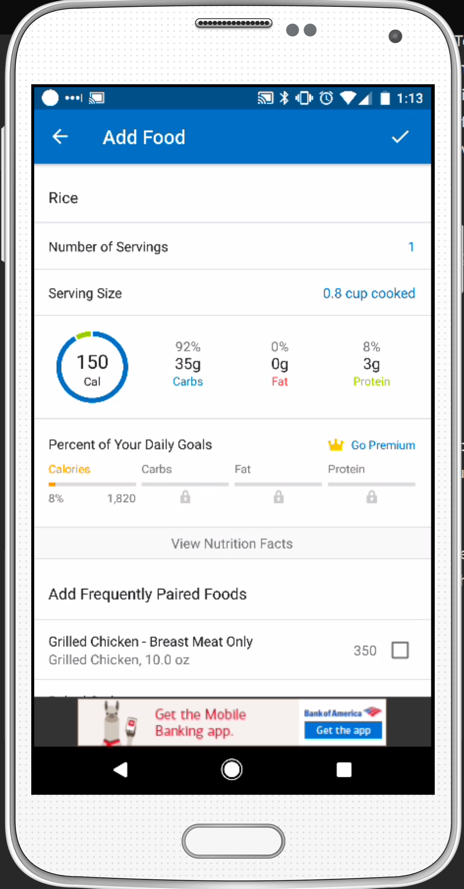

Next, we’ll add 3/4 cup of rice.
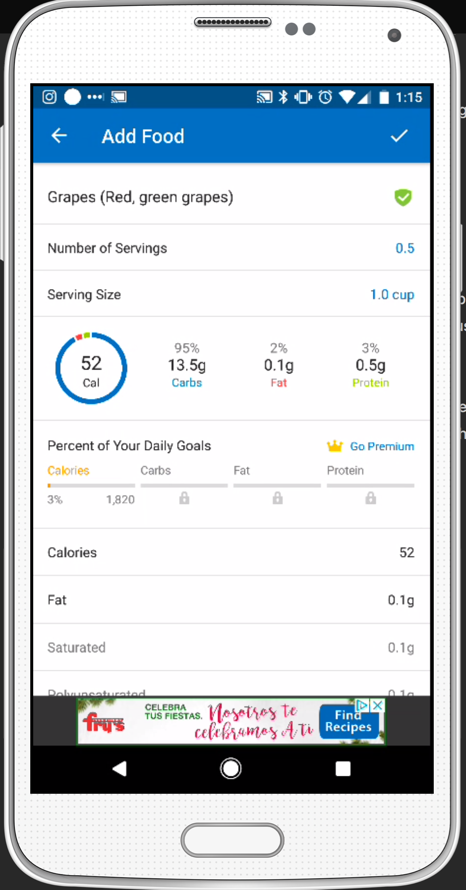

Finally, we’ll add the red grapes.
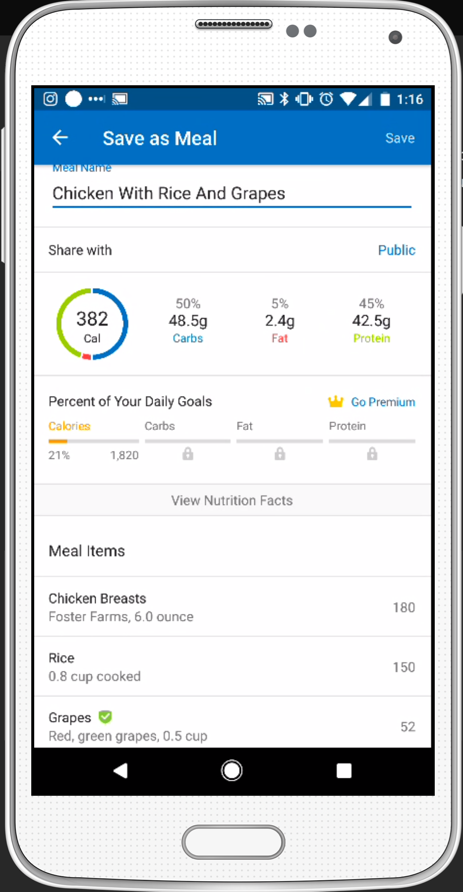

Now we can hit the menu option and select “Save Meal” to save all the ingredients as a meal.
Anytime you eat that meal, you can add it to your food log in one step by choosing “Recipes” and “Log it”. #done
Create Meal Plans from Your Recipes
Take some time and enter some of your favorite recipes. Once you’ve done that, log them into MyFitnessPal and see how they stack up.
Do they combine together to hit your goals for macros?
On your first attempt, they most likely won’t. That’s ok, and I’ll show you how to adjust. Let’s assume you entered the following:
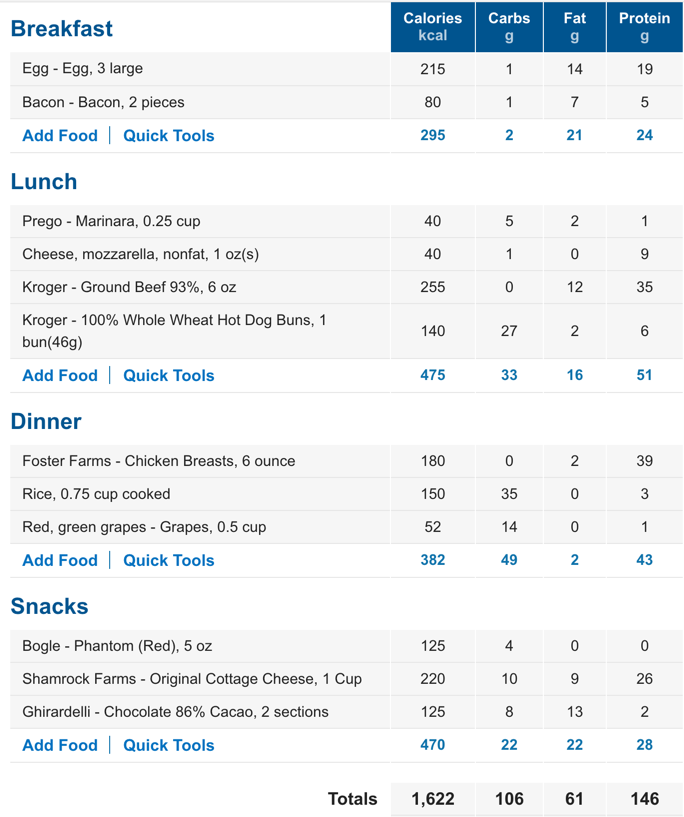

Your daily goals are 1200 calories: 30% carbs, 40% protein, and 30% fat ratio. Let’s see how this stacks up.
106 g carbs * 4 calories per gram = 424 calories
146 g protein * 4 calories per gram = 584 calories
61 g fat * 9 calories per gram = 549 calories
424 + 584 + 549 = 1557, so we're over on calories.
Let’s see what our macro ratio is. This will suggest to us the best place to cut back.
424 / 1200 = .35, or 35% for carbs
584 / 1200 = .49 or 49% for protein
549 / 1200 = .46 or 46% for fat
Adjusting Our Meal Plan
We’ve exceeded our macro ratio by 5% in carbs, 9% in protein, and 16% in fat. Using this information and the knowledge that fat has more calories per gram than carbs or protein, let’s look at our proposed meal plan. Carbs and protein both have four calories per gram. In a 1200-calorie meal plan, we can do a little math to learn that 5% of 1200 is 60 calories:
So 60 calories from carbs or protein are 5% of our meal plan. Knowing that Each gram of carbs or protein is four calories, we can determine that 15 grams of carbs or protein produce a 5% change in our macros:
60 calories / 4 calories per gram = 15 grams
Since we’re over on our carbs by 5%, we now know that reducing our carb intake by 15 grams will bring carbs to our desired ratio.
We’re over on protein by 9%, which is roughly two times 5%. We can make a ballpark estimate to say we need to reduce our protein by 30 grams.
Let’s do the same math for fats. Again, 5% of 1200 calories is still 60 calories. With fat bringing nine calories per gram, we can determine that 6.67 grams of fat results in a 5% change to our meal plan:
60 calories / 9 calories per gram = 6.67 grams
To reduce our fat by 15%, we multiply
So we’ve broken our meal plan into a nice, workable number: 5%. We want to reduce our carbs by 5%, protein by 10%, and fats by 15%. All are multiples of 5, which makes the math easier.
We converted the number “5%” into grams. For carbs and protein, 5% of our daily intake equals 15 grams. For fat, 5% of our daily intake = 6.67 grams.
We want to cut the carbs in our meal plan by 5%, so we need to eliminate 15 grams of carbs.
We want to cut the protein in our meal plan by 10%, so we need to eliminate 30 grams of protein.
We want to cut the fat in our meal plan by 15%, so we need to eliminate 20 grams.
Let’s see where we can do that.
Take a look at that cottage cheese. It has 10 g of carbs, 26 g of protein, and 9 g of fat. Eliminating that takes us a long way toward our goal, leaving only another 5 g of carbs, 4 g of protein, and 11 g of fat to cut.
Let’s focus on that chocolate next. It has 8 g of carbs, 2 g of protein, and 13 g of fat. If we eliminate that, we are now under our goal for carbs by 3 g, over by 2 g on protein, and under our goal for fat by 2 g.
Let’s update our meal plan to get a final number:
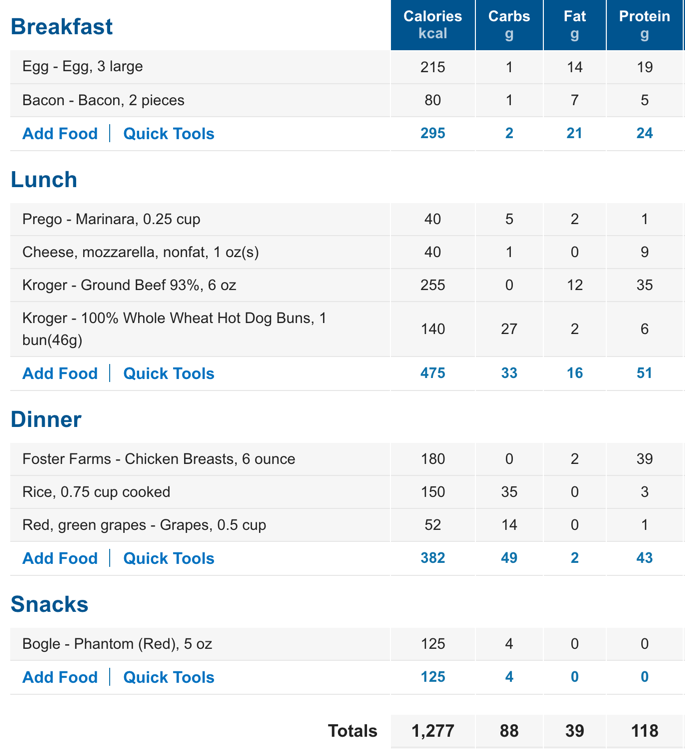

We’re now at 1,277 calories with 88 g of carbs, 118 g of protein, and 39 g of fat.
We can calculate the calories from our macros:
88 g of carbs * 4 calories per gram = 352 calories
118 g of protein * 4 calories per gram = 472 calories
39 g of fat * 9 calories per gram = 351 calories
And convert that to our ratio:
352 calories from carbs / 1200 calories per day = .29 or 29%
472 calories from protein / 1200 calories per day = .39 or 39%
351 calories from fat / 1200 calories per day = .20 or 29%
You know what? 29% carbs/ 39% protein/ 29% fat is close enough to a 30/40/30 ratio for me!
Note: The astute reader may notice that our calories from macros do not add up to our total calorie count. This is due to calories from sugar alcohols. Some of the foods on our meal plan add calories that aren’t in the form of carbs, fats, or protein (such as the glass of wine). That’s ok. We don’t have to be exact here. I promise that if you follow this plan, you’ll be close enough to start hitting your goals. Sure, you can micro-manage and stress over each individual calorie, but in the long run: it will add much stress to your life for little gain.
Now that you have a meal plan for a single day, it’s time to expand that into an entire week. As you’ve realized, this is a lot of work. This is the primary reason I eat the same foods frequently. It makes it easier. And before you say ” Ewww, that’s gross, I can’t do that!” Let’s remember: most likely, you are going to the same restaurants, ordering the same thing (whether it be a salad, a wrap, a burger, or a taco). You are already doing this, and you don’t realize it. Make this work for you!
Once you have your full week of meals planned, look at what you’ll need, create a list and head to the store! Purchase the ingredients on your shopping list (and nothing else!), then head home and prepare as much of this as possible to set yourself up for success in the week ahead.
Today’s Tasks
Don’t forget to complete today’s tasks for the challenge, including our new task: sticking to your meal plan.
- Drink 1 gallon of water
- Workout for 45 minutes
- Read ten pages from your book
- Stick to your meal plan
Once completed, be sure to head over to the tracking site and mark them as completed to track your progress for the challenge. Tomorrow we will be learning about how and when to involve your doctor.
Involving Your Doctor
You mustn’t go on this journey alone. You need a support group, someone to help hold you accountable, and someone to lean on when you have moments of weakness.
If you have medical issues that impact your diet (like cardiovascular disease, kidney disease, autoimmune issues, diabetes, etc..…), running your meal plan past your doctors before taking action is good. For those of you in this category, your doctor has likely given you some suggestions:
- cut back on protein
- limit fiber
- don’t eat lots of fat
While your doctor’s suggestions seem reasonable and prudent for your condition, you may discover they are a bit… vague. For example, how much protein constitutes “cutting back”? How much fiber is considered “limited”? How much fat is “a lot of fat” (not to mention the distinction between healthy and unhealthy fat)?
Here’s where your newly-acquired knowledge comes in:
- Write down what you plan to eat.
- Add up the macros.
- Print it out.
- Take it to your doctor and discuss it with them.
Have a meaningful conversation with your doctor. If he or she has concerns, get specific recommendations from them on what should be changed. This means turning statements like ” I’d like to see you cut back on protein.” into ” I’d like to see you keep your protein under 50g daily and only from lean protein sources like chicken and fish.” Your doctor’s advice must be actionable and measurable. You don’t know what steps to follow if it isn’t actionable. If it isn’t measurable, you won’t know if you follow it correctly.
Word of Warning: Your doctor may be unprepared for this. Many of your doctor’s patients don’t have a plan on how they are going to follow his or her advice. When you show up with a plan, seeking specific guidance and input, your doctor may need some time to evaluate it and offer a quality evaluation.
That’s ok.
Allow that process to happen, and follow up with them. Finally, seek an alternative if you’re not getting the necessary answers.
Today’s Tasks
Don’t forget to complete today’s tasks for the challenge. Today we add a new task to your list: sticking to your meal plan.
- Drink 1 gallon of water
- Workout for 45 minutes
- Read ten pages from your book
- Stick to your meal plan
Once completed, head to the tracking site and mark them as completed to track your progress for the challenge. With our meal planning in full swing, tomorrow we will talk about fasting: how and when to do it.
Intermittent Fasting
The words “intermittent fasting” strike fear into the hearts of many.
Bear with me; it’s not the horrible, dreaded hunger strike you imagine.


Let’s start with the basics:
- For men, it means eating all your daily food in an 8-hour window.
- For women, it means eating all your daily food in a 10-hour window.
- You can pick your eating window. Go with whatever works for your schedule. You should, however, stay consistent from one day to the next.
You’ll be asleep for eight of the remaining hours anyway (What?!?! Who gets 8 hours of sleep?!?!” you say? Hang on, I’ll come back to that). You’ll be at work for at least another 8 hours (plus more if you commute). Guess what? That’s 16 hours committed to other tasks already! The rest of the time is available to eat!
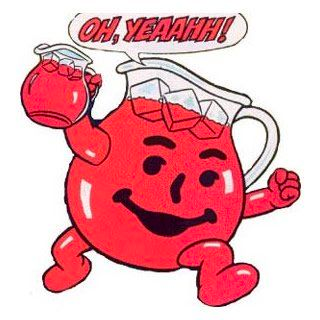

But wait, there’s more!
Because the food you are eating follows your macro profile, during that 8 or 10-hour period, you will consume enough calories for the entire 24-hour period. The food is also high in healthy fats and proteins, so you won’t experience a carb crash and be hungry an hour after your feeding window closes.
There is another benefit, too: because you contain your eating to an 8 or 10-hour window, your digestive system can rest. Your entire life, your digestive system has been working hard for you (despite not having the best working conditions). Doesn’t it need a little love and care too?
Putting it into action
Example Schedule #1
Here is what a typical day might look like and how to work your feeding window into it:
5:00 am - Wake up, hit the gym, or get in some early morning work
8:00 am - Official office hours begin. Drink coffee, tea, or water.
11:00 am - Starting to get hungry by now. Drinking a large glass of water helps to take your mind off of it.
12:00 pm - The feeding window opens. This is the first meal. It helps to have something ready to eat because delays in getting food into your belly lead you to make bad choices.
3:00 - 4:00 pm - Sometime during this window, you start getting hungry again. Have another smaller meal or snack, maybe a cup of low-fat cottage cheese and water.
6:00 pm - It’s dinner time! Finish your day with 8-10 oz of grilled chicken breast, a salad made from bell peppers, spinach, balsamic vinaigrette, and a few (4) tablespoons of hummus. This meal is packed with protein and fat, so it will take a long time to digest. This gives you ample runway to close out the feeding window.
7:00 pm - If there’s room left in your meal plan (thanks to hitting the gym earlier in the day), finish off with some dark chocolate
8:00 pm - The feeding window closes, and you are stuffed. You wouldn’t want to eat more if you could!
Example Schedule #2
This schedule is for people who love breakfast. So you start eating a little earlier, and thanks to a 10-hour window, you still have time to have dinner with the family (when everyone else’s schedule aligns, too!).
7:00 am - Shower, dress, and commute to start your day at work. You can have a coffee, Amino Energy or BCAAs to sip on during your commute.
10:30 am - Bacon and eggs at work (thanks to a fantastic technique to cook everything deliciously in the microwave.
12:30 pm - Snack on an apple and some Chicharrónes.
2:30 - This is your largest meal of the day with 4-6 oz of chicken breast either in a mixed green salad with Ranch dressing or accompanied by butternut squash risotto
4:30 is snack time again with homemade granola
6:30 pm - at the gym.
8:00 - Dinner with the family.
Having your food prepped and prepared at the start of the week allows you to avoid extra work cooking and cleaning each night and close your feeding window with a relaxed evening.
You may have noticed the first meal plan includes a lot of dairy. You may get a little worried if you are lactose intolerant or have an aversion to dairy. Relax. Note that the second meal plan contains no dairy. It also uses multiple, smaller meals throughout the day, where the first has 2 or 3. You can create a meal plan that works for you, regardless of your dietary preferences, allergens, or conditions. Yup, that includes you Vegans. And the Vegetarians. And the Paleo crowd. And anyone else I failed to mention!
Look, I know you have a hectic schedule without a lot of free time! That’s what I love about intermittent fasting: it’s controlled, planned, and doesn’t suck more time out of an already busy day. Bonus: your body gets the food it needs, giving you more energy to power through the day.
Oh yeah…
About those 8 hours of sleep: because you spent your time planning your meals and didn’t spend a lot of time cooking due to prepping earlier in the week, and you were productive outside of your eating window: you have a lot of leftover time.
Catch up on that sleep!
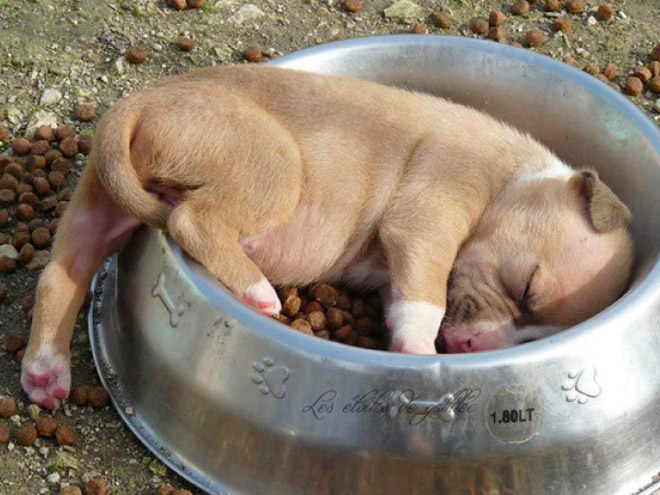

Today’s Tasks
Don’t forget to complete today’s tasks for the challenge.
- Drink 1 gallon of water
- Workout for 45 minutes
- Read ten pages from your book
- Stick to your meal plan
Once completed, head to the tracking site and mark them as completed to track your progress for the challenge. Tomorrow you’ll be able to earn extra points in the challenge in the first surprise element!
24-Hour Fast
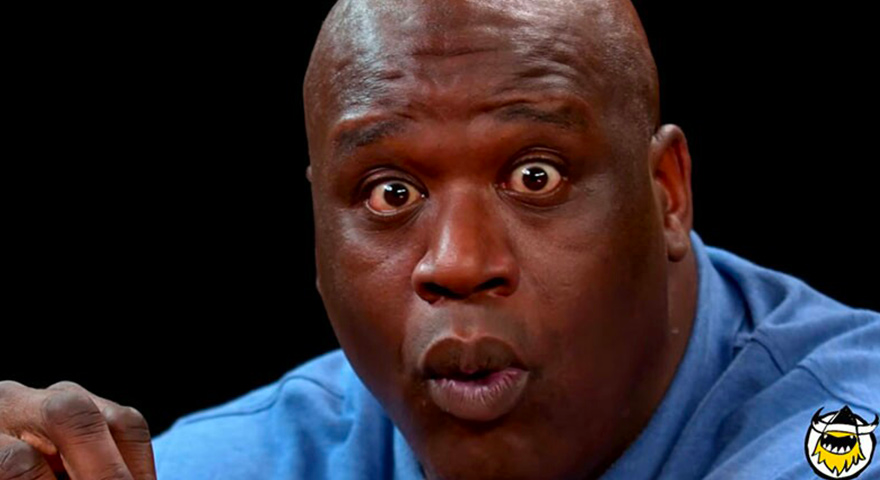

Surprise! Today is the first surprise challenge of the 45-Day Challenge. For one day during the next week, fast for 24 hours. You can pick any day that works for you. I try to pair it with days I’m pretty busy to avoid having a lot of idle time to think about food.
“Set aside a certain number of days, during which you shall be content with the scantiest and cheapest fare, with course and rough dress, saying to yourself, ‘ Is this the condition that I feared?”
– Seneca
If you’ve never done a 24-hour fast before, it’s an exciting challenge to try. You will learn that it’s easier than you think, and when you think you are hungry, the feeling passes within a few minutes whether you actually eat or not.
I try to fast for at least 24 hours once per month. There may be some health benefits, but for me, the motivator is discipline: fasting allows me to practice discipline and focus in less-than-ideal circumstances. You never know when you will need this skill and when you need it: it’s too late to learn it. It’s also a gentle reminder that things could be much worse. I’m fasting by choice when many worldwide do so out of necessity.
Here are some things I’ve learned:
- Your gallon of water is your friend: a belly full of water keeps you from feeling hungry
- Carbonated water is a refreshing change up from regular water
- You can still workout with just as much energy and power
- Timing matters: while you can pick any 24 hours, I’ve found it easiest to start after dinner on day one and fast until dinner the next day. This lines the most challenging part of the fast up with the time of day when you have the least opportunity to do anything about it: your workday. The final hours of the challenge are during the end of your workday, and most people don’t have the option to stop working to address it. By the time you do, it’s dinner time anyway.
- Eat your regular meal at the beginning and end of the challenge. There is no need to “stock up” or “replenish” for the fast. Doing so results in you feeling miserable from overeating. Your body has enough fuel stored for three weeks; you’ll make it through the 24 hours just fine.
If you have medical concerns, consult your doctor before taking on this challenge. This challenge is optional but highly recommended because of what it teaches you. Once completed, check the box in the tracking sheet and share what you’ve learned.
Today’s Tasks
Don’t forget to complete today’s tasks for the challenge.
- Drink 1 gallon of water
- Workout for 45 minutes
- Read ten pages from your book
- Stick to your meal plan
Once completed, head to the tracking site and mark them as completed to track your progress for the challenge. Tomorrow we will be covering my favorite nutrition topic: CHEAT DAYS!
Cheat Days


Aaaahhh… the much-loved Cheat Day. It’s the chance to throw everything to the wind and live a little. Or is it?
As you’re beginning to see, the key here is discipline. You’re right: a cheat day can do wonders for keeping you on track in many areas. It’s a little indulgence that provides a dopamine hit, a sugar spike, and a little freedom from the disciplined grind of creating the “you.” It’s also beneficial for other areas of your life, for example, your community. Grandma takes pride in the recipe for her favorite dessert, given to her by her mother, who received it from her mother. It makes her feel like she can still contribute to the family in her older age, and who are we to deprive her of that memory? Besides, we’ve all been around those people who turn their noses up in disgust at something that doesn’t conform to their chosen “lifestyle of the week.”


The potential problem here is when things drift out of control. You have a slice of Grandma’s tasty dessert, which leads to some chips and salsa, then… “Oh, why not? I’ll have a drink too,” followed by waking up the next morning feeling like shit. You already feel horrible, so some pancakes, bacon, and chocolate milk may help.
Lol, I guess today is shot too…


The next thing you know, it’s four months later.
Defining the barriers
So how can we indulge in some of our favorite foods and drinks without letting things spiral out of control? One way is by defining barriers: for example, one of the challenge rules is no alcohol, except once per week when meeting with other participants. This provides the opportunity to indulge but defines the constraints of when it happens. It also sets the stage for the second tool to manage cheat days: changing the relationship with food.
By wrapping the cheat into the meeting with others in the challenge, we’re wrapping it in the context of one of our other spinning plates: community. Sure, you get to have a drink or two, but you’ll also get to talk about the challenge and other areas of life with like-minded people. This facilitates a significant transition in your brain: it becomes less about the cheat meal and more about catering to the five areas of your life for balance. Over time, the food or drink becomes less important than the event itself.
Make deliberate choices
Once you decide to embrace a cheat day occasionally, deliberately define how and when that will happen. Make deliberate choices: if you’re going to cheat, sitting on your couch alone pounding a pint of Ben and Jerry’s is not as satisfying as going out for ice cream with friends. Make it worthwhile, deliberate, make it known (i.e., let your friends know today is a cheat day), and make it time-boxed. Best-selling author Tim Ferriss has written about his cheat days in detail, including staying up to midnight with friends to get those last few cupcakes devoured before the clock tolls twelve. This approach satisfies the desire to eat junk food, embraces friendship and community, is time-boxed, and at 12:01 AM, everyone knows it’s over.
Today’s Tasks
Don’t forget to complete today’s tasks for the challenge.
- Drink 1 gallon of water
- Workout for 45 minutes
- Read ten pages from your book
- Stick to your meal plan (unless you are fasting)
Once completed, head over to the tracking site and mark them as completed to track your progress for the challenge. Tomorrow we talk more about foods that fit/don’t fit into a healthy meal plan when we discuss “Are chocolate and wine healthy?”
Is Chocolate (or Wine) Healthy?
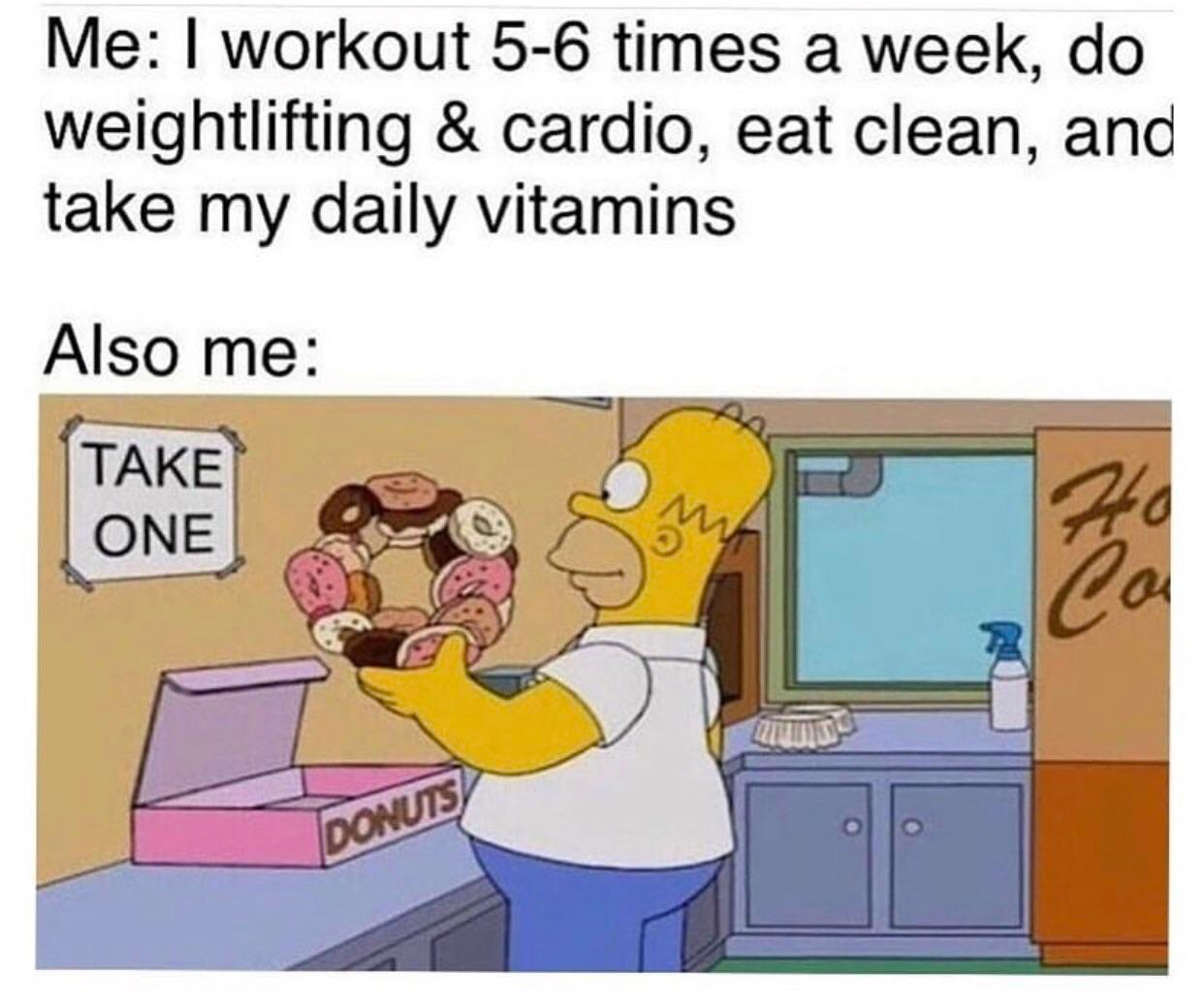

It’s only a matter of time before you stumble across an article or hear someone say, “Chocolate is healthy; it reduces stress and heart disease" or “Wine is healthy; it has antioxidants.” But is that really the case?
Maybe
There have been some studies that indicate this is true, but it comes with caveats. From a medical perspective, for something to be true, it must be tested across many people. An equally sized group must not be part of the study to serve as a baseline. The results must be peer-reviewed for accuracy and bias by the researchers. The study must be done long enough to determine the impact on individuals over the course of their life. The results must be compelling enough that general guidelines can be given to the mass public, and once misinterpreted (because no one reads the directions), will not result in harm from misuse.
This level of detail doesn’t exist for chocolate and wine, as well as many of the other “biohacks” that make for great clickbait articles.
A Sensible Approach
Look at it this way: cocaine is highly effective at boosting energy. It contains no added sugar, is easy to use, and is vegetarian. But no one is writing articles advocating replacing your morning coffee with an 8-ball.
Why?
Aside from the issue’s legality, the risk/reward ratio isn’t there. The same is true for treats like chocolate and wine. They have one beneficial property, but other properties may outweigh those benefits.
If you want to indulge in chocolate or wine, do so. Treat it for what it is: a treat. Ensure it fits your macros and doesn’t become a part of your everyday routine. Remember that everything you read aside from published, peer-reviewed clinical studies are written by someone trying to sell you something (and sometimes even those). Buyer beware.
Today’s Tasks
Don’t forget to complete today’s tasks for the challenge.
- Drink 1 gallon of water
- Workout for 45 minutes
- Read ten pages from your book
- Stick to your meal plan
Once completed, head to the tracking site and mark them as completed to track your progress for the challenge. Tomorrow you’ll have your chance to earn ten extra points in the challenge in a quiz reviewing what we’ve learned in the first two weeks of our challenge. Speaking of which, how great is that? You’ve got two weeks of this challenge under your belt. How are things going for you?
Supplements And Vitamins
The supplement and vitamin industry is $40 billion per year industry. That’s a lot of money. Whenever there is that much money at stake, people will be willing and available to say whatever it takes to separate you from your hard-earned cash. Buyer beware.
What’s important
Let’s start with the fundamentals: what do you really need. It’s likely that your current nutrition plan, despite all the work you put into it, is leaving you short on vitamins and minerals. A good multivitamin can help overcome this deficit. A trip to your doctor for your annual physical (we’ll cover that next week) can reveal any deficiencies specific to you, and your doctor can recommend the appropriate course of action.
For men, checking your testosterone levels as you age is essential. For women, it’s important to check your estrogen levels. While you can order test-at-home kits for both of these, I think it’s better to involve your doctor but also get a copy of the results and do your research. The range of acceptable values your doctor uses is based on research using the average American population. Guess what? Forty percent of the population is obese, so the average numbers skew themselves in that direction. This is why you need to implement a combination of your doctor + your research.
For the rest of the available supplements on the market: only take what you need if your tests indicate you are deficient in that area. Think you need more potassium? Get it tested. Think you need more magnesium? Get it tested. Repeat for everything you think you need. I get it. This contradicts many of the “advice” you get from the Internet. So I’ll say one last word on that: buyer beware. Most of the information you get comes from someone trying to either sell you a product directly or draw you to their website, where they can display ads for someone who is (and take a nice little commission). The vitamin and supplement market is largely unregulated, and the sales tactics used reflect that.
One last thought today on a personal pet peeve of mine: pre-workout supplements.
PreWorkout Supplements
We’re here to pump you up!
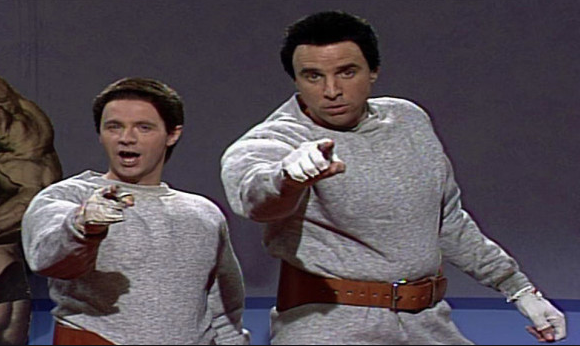

I know why you like the pre-workout juice.
Sip down that fruit-flavored goodness, and you feel your muscles getting amped up within minutes.
You lift more.
You run faster.
You get a bigger pump from your gym time.
Magic juice makes me go faster.
Here’s the catch: sooner or later, all that excessive firing of your nerve synapses will take its toll. In my younger days, I did drugs. A lot. No, seriously, a lot. Like Keith Richards levels of drugs. I can tell you firsthand about the similarities between the feelings resulting from pre-workout supplements and the feelings resulting from certain drugs I’ve used. There are too many similarities not to have similar long-term effects.
Twenty years from now, having enough functioning synapses and brain cells to link together cohesive thoughts will be more important to you than the extra 5 lbs you got on your deadlift from taking those supplements.
If you’re a professionally competing athlete, you must weigh the pros and cons of millions of dollars against your long-term health. For the everyday person, it’s just not worth it.


If you need something to start your workout, try some black coffee or tea for a caffeine jump start. If caffeine doesn’t give you the boost you’re looking for, what does that tell you?
You have a dependency on it.
Rather than looking for a bigger dose, cut the caffeine out. Suck it up, go through the withdrawals, then add it back in, mindful of how much to take.
Amino Acids (also known as BCAAs or Amino Energy by some labels) contain caffeine and BCAAs to provide energy and stimulation. Be sure to read the labels to choose one that will work with your current fasted state and macro ratio. (In other words, check how many carbs are included. Many of these supplements add unnecessary ingredients.)
I know that’s not the answer you wanted to hear, but it’s the answer you need to hear.
Today’s Tasks
Don’t forget to complete today’s tasks for the challenge.
- Drink 1 gallon of water
- Workout for 45 minutes
- Read ten pages from your book
- Stick to your meal plan (unless you are fasting)
Once completed, head to the tracking site and mark them as completed to track your progress for the challenge. Tomorrow we’ll cover strategies for eating healthy when eating out.
Eating Healthy When Eating Out
Eating out can strike fear into the hearts of those finally seeing progress with their nutrition goals. “Is this where it all comes to an end?” Today, we’ll discuss different strategies to navigate this slippery slope.
Mental Preparation
The number one key to successfully eating out is mental preparation. Define the event for what it is: a social event. What is the real purpose of this event? A birthday celebration? Meeting with a potential new client? Get together with coworkers? Why are you going to a restaurant? If you are going because there is nothing to eat in your house, don’t go. Go to the grocery store instead. Otherwise, acknowledge that this is the meeting place for an event and it is not about the food. Making this mental transition shifts the relationship with the event from being about the deep-fried mozzarella sticks to the people you are there with.
What to eat
I think there are two main strategies for choosing what to eat. The right one depends on how often you are in this situation.
If you find yourself at restaurants frequently, you must exercise discipline to avoid sabotaging your goals. Tips that can help with this include:
- Look for items on the menu that closely resemble what you would normally eat
- Ask for calorie-laden sauces, coatings, breading, and the like to be served on the side or left off entirely. Remember: unless you are at Chuck E. Cheese, a restaurant’s primary business is cooking your food. You can ask for it to be cooked to your specifications; you’re paying them to do so. (but don’t go full-Karen mode unless you like a good spit burger)


- Stick with simple entrees to make it easier to track your macros. It’s much easier to enter chicken + baked potato + butter + salad + dressing than to figure out what is in their “chicken parmesan surprise.”
If you don’t visit restaurants frequently, consider making this a cheat meal. Eat what you want, but don’t abuse the scenario. Have the burger and fries, but avoid the buffalo wings appetizer and cookie skillet dessert. The second you step out of the restaurant put it behind you. It’s over. Move on.
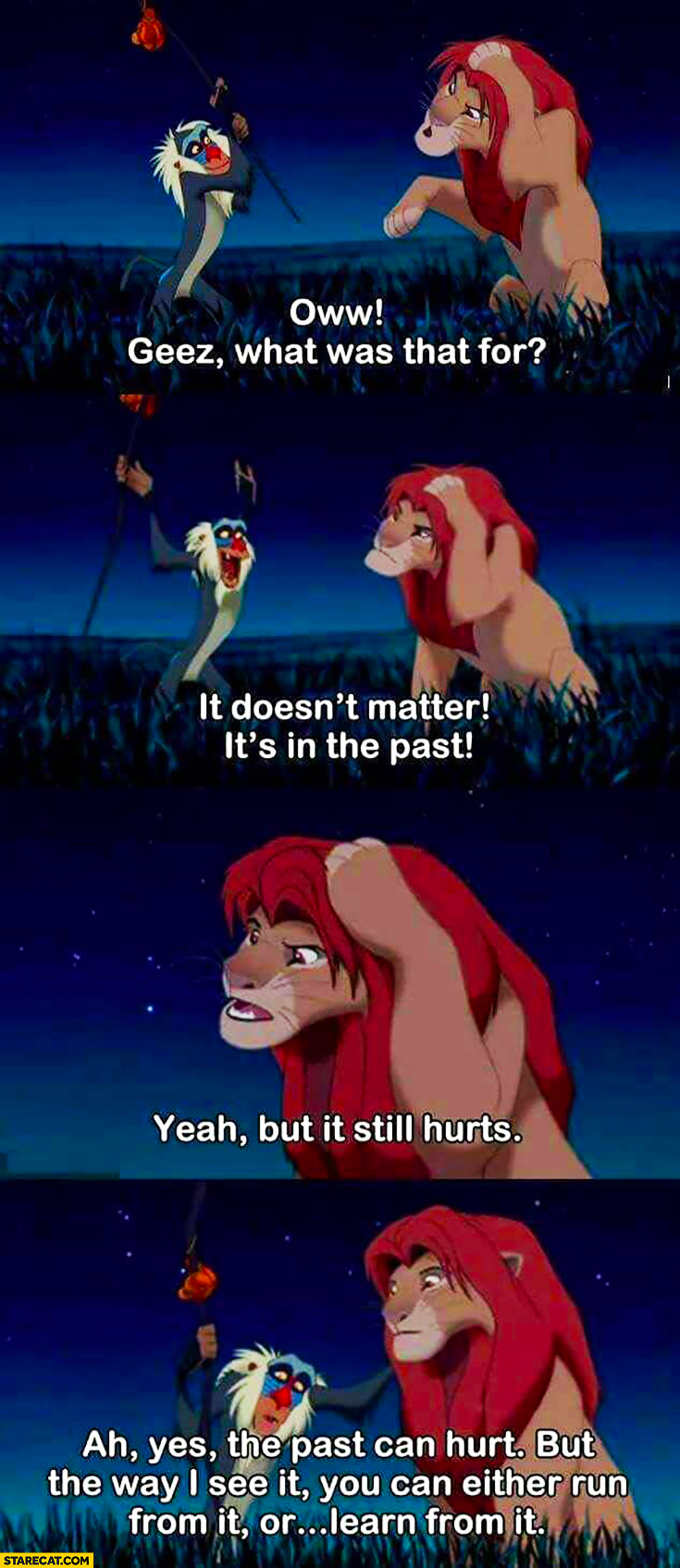

Long-Term Strategies
If, in hindsight, you didn’t make the choices you’d like to have made, step one is to stop beating yourself up over it.
The first thing to do when you find yourself in a hole is to stop digging.
–Unknown
Ask yourself how you would like to change things if you had to do it over. Now think about the moments just before making that decision you regret. What were you thinking? What were you feeling? What would be different about your thoughts and feelings now that would lead to a better decision? Take a moment and visualize the experience all over, but replace the feelings you had with the new feelings, then imagine yourself making that better decision. This may sound dumb, but it honestly works. Your subconscious brain struggles to identify the difference between reality and imagination. We can use this to our advantage by imagining how we’d like to respond, then when we encounter the scenario in real life, our subconscious responds in the way we’ve practiced.
It works for Michael Phelps, and you can make it work for you too.
Q: If you were stranded on a deserted island and could only have three things, what would you ask for?
A: Michael Phelps, a saddle, and a gold medal on a stick.
Today’s Tasks
Don’t forget to complete today’s tasks for the challenge.
- Drink 1 gallon of water
- Workout for 45 minutes
- Read ten pages from your book
- Stick to your meal plan
Once completed, head to the tracking site and mark them as completed to track your progress for the challenge. Tomorrow we address the last topic in our nutrition portion of this challenge. It’s a subject more taboo than politics, religion, and alien abductions in trailer parks: the fourth macro.
May The 4th Be With You


So far, we’ve talked about protein, carbs, and fats. There is another macro, and no one likes to talk about it. Ironically, this mysterious macro may be responsible for more happy marriages, childbirths, and white people dancing than all the other macros combined. Is this some secret ingredient purposely squashed by Big Pharma? Is it a government conspiracy? Is it the product of aliens?
Not quite. It’s our good friend, alcohol.
Think about this: how does a Michelob Ultra only have 2.6g of carbs but 95 calories? Carbs have four calories per gram, so 2.6 X 4 is 10.4 calories. Where do the remaining calories come from? It’s alcohol. Alcohol macros contain seven calories per gram, and this is what makes up the remaining calories. This means it can also be a source of hidden calories working to sabotage your goals.
One possible explanation for the lack of information on alcohol macros may be that the number of grams of alcohol we need for a healthy diet is zero. (I know, I know… you may argue that, but I’m saying it anyway) You can’t live without protein, carbs, and fat, but you can live without alcohol.
This doesn’t mean alcohol can’t be a part of your diet. If you choose to drink alcohol, it should be a tiny part of your overall diet, and you should be aware of its impact on your overall nutritional goals. For example, a glass of red wine has about 125 calories. If your calorie requirement is 1500 calories, and you are reducing that by 10% to create a deficit for weight loss, your daily caloric intake is 1350 calories. Now let’s add two glasses of wine at dinner: 250 calories. That’s 18.5% of your daily calories, bringing your total calorie intake to 1600 calories. There goes your calorie deficit and the weight loss you hoped to promote.
This doesn’t mean you should cut back on one of the other macros to make room for alcohol. Remember, those macros are required by your body to keep the engine running. Occasional indulgence will not sabotage your goals—exercise moderation. Associate alcohol with social events. Make it about the people you are with, not the booze, and enjoy. Enjoy the drink. Enjoy the company. Enjoy the environment. Enjoy the moment. You’ll find that making it an experience satisfies the craving and inspires you to get back on track and work harder toward your goals.
When you do drink, limit any extra calories that aren’t necessary. Avoid sugary or fruity alcoholic drinks as they may contain mixers and fruit juices that increase the calories in the drink. Martinis, whiskey, tequila, wine, and drinks mixed with tonic or club soda make excellent choices.


Stay thirsty, my friends.
Today’s Tasks
Don’t forget to complete today’s tasks for the challenge.
- Drink 1 gallon of water
- Workout for 45 minutes
- Read ten pages from your book
- Stick to your meal plan
Once completed, head to the tracking site and mark them as completed to track your progress for the challenge. This challenge is about learning to balance the spinning plates that represent the key areas of our life. Tomorrow we move our focus to our second spinning plate: physical fitness. We’ll examine topics such as why physical fitness matters, failure, and defining intent.
Subsections of Physical
What's Your "Why"?
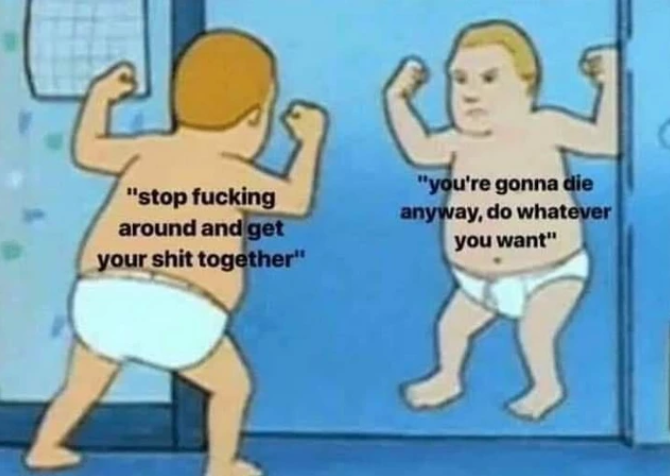

Welcome
Welcome to the physical component of the challenge, and congratulations on making it through the nutrition component. Over the last 2 1/2 weeks, we’ve covered all the core concepts you need to build and maintain a sustainable nutrition plan for life. Don’t worry if you still have questions. You weren’t successful the first time you tried to walk, ride a bike, or do a pull-up. The important thing is that if you fall six times, you get up 7.
Once the challenge is over, you can go back through these emails and reread them, learning new things that you may have missed the first time.
Or maybe I’ll turn this all into a book… ¯\(ツ)/¯
Why…
Why do you work out? It’s easy to say “to get in shape,” but what does that really mean? Who cares? Why does it matter? What is the fundamental, uncompromising goal that drives your physical fitness plan? Most of us don’t have one. That’s why we struggle with fitness. We do it when it’s easy, but because there isn’t a core life-defining reason behind it, it’s easy to quit too.
Spend a few minutes to dig into “why.” What does it mean to be in shape, and why does it matter? For me, it’s meditative, spiritual; it’s the foundation of my purpose in life.
Meditative
Pursuing physical fitness can have meditative qualities. When performing a heavy lift, you have to focus. Think about performing one clean and jerk: before approaching the bar, you visualize what a perfect lift looks and feels like. You step up to the bar. Set your feet hip-width apart. Take a deep breath and hold it. Bend down to the bar, and wrap your hands tightly around the bar at shoulder width. Raise your hips to engage your hamstrings. Bring your chest up. Relax your arms. Pull. Straighten your back and pull your elbows high when the bar passes your knees. Feel the bar accelerate; when it reaches its peak, drop underneath and catch it in a front rack position. Engage your butt and legs to drive the bar up again. Use your arms to drive your body back underneath the bar. Catch it with your arms locked out. Stand up straight. Lower the bar to the front rack position. Drop the bar to waist level and lower it back to the ground while keeping your chest up and a neutral spine.
One rep.
Notice what is not a part of the movement: what time of day it is, who is talking, what you’re going to have for lunch, that meeting you have at work. Focusing on every rep in your workout provides the opportunity to free your mind from the daily grind. That’s one of the goals of meditation. To intentionally direct the thought and power of your mind to a specific task, whether lifting a weight or focusing on your breathing. Doing so in the context of physical fitness can leave you physically exhausted but mentally refreshed. Many times this allows your brain the time it needs to think of creative solutions to problems that have been plaguing you (similar to those great ideas you get while in the shower).
##Spiritual
Another aspect of fitness that can be motivating is exploring what I call the spiritual side of it. How much can you do? What is your actual limit? When your brain says you’re done, you’re only at about 40% of your physical capability. You only have one life, one body, and as far as I know, there is no credit at the end for unused portions.
No man has the right to be an amateur in the matter of physical training. It is a shame for a man to grow old without seeing the beauty and strength of which his body is capable.
–Socrates
Death itself does not scare me; we all go through it. What scares me is after death, seeing what I was truly capable of and not even being close.
Purpose in life
What is your legacy? What is your purpose in life? It may be to serve as an inspiration to your children, family, or community. It could be to lead by example. Oddly, no matter the purpose, it will be filled with obstacles and challenges. Physical training provides the discipline as well as strength to navigate those challenges.


We may not have the good fortune to live in prosperous times like we do right now. You may be shocked at that statement. “Right now?” Yes. Right now. I get it. There’s a global pandemic. We’re being constantly manipulated by organizations for profit. The list of bad things goes on, but it’s still pretty good. Review history; it doesn’t take long to realize how much worse things can get. When they do, the strong will survive, and it will be too late for those who want to get strong. I owe it to my family, friends, and community to be ready for hard times every day. If hard times don’t come today, my training is still helpful in fulfilling my purpose in other areas of life.
Reflect on why your training is vital to you. Not just the “look sexy” aspect but what it means as a core component of your life. It will change the way you work out. It will change the quality of your workout. It will change your mental approach to working out.
Today’s Tasks
Don’t forget to complete today’s tasks for the challenge.
- Drink 1 gallon of water
- Workout for 45 minutes
- Read ten pages from your book
- Stick to your meal plan
Once completed, head to the tracking site and mark them as completed to track your progress for the challenge. Tomorrow we look at failure. Is it good? Is it bad? Should you avoid it?
Plan To Fail
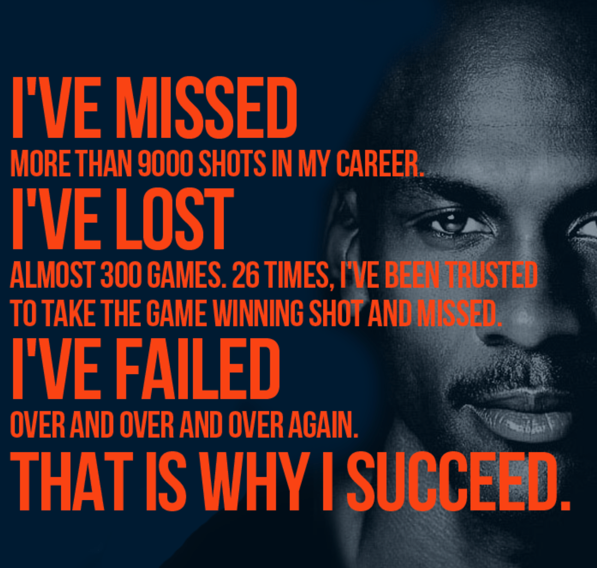

Think about this: as a toddler, were you successful on your first attempt to walk? Did you try once and decide it wasn’t for you?
Probably not.
You got up. You fell. You got up again. Eventually, you got it, which is cool because I can’t imagine your life if you still resorted to crawling everywhere as an adult.
Somewhere along the way, though, we learned that failure was bad. We were taught that failure means losing, and no one wants to be a loser. It’s time to unlearn that behavior. You’ll either fail or you’ll never accomplish anything significant. Sure, sometimes failure hurts. That’s ok because that’s usually where the lesson is, and nothing is permanent.
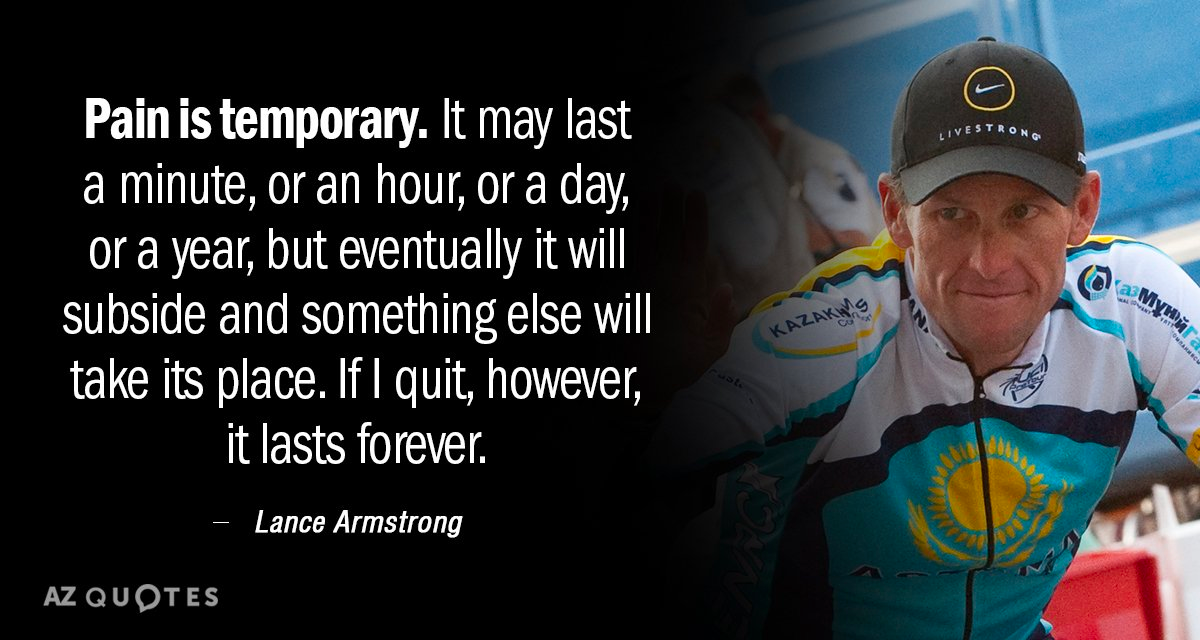

Fail Fast
Personally, I use the motto “fail fast.” When I wake up each day, my job is to fail as fast as possible. Doing so eliminates all of the ways that won’t accomplish my goals for the day, leaving only the ways that will help me accomplish them. Failing fast also implies that I’m looking for failure. This helps identify it earlier and avoids spending more time than is necessary on it.
Planning To Fail
Let’s bring all of this hypothetical talk to a real-world example: how do you plan to fail? You first have to identify what success and failure look like. Let’s imagine doing a back squat. A successful back squat involves racking the bar on your back, squatting below parallel, keeping your chest upright, and returning to a standing position. So what does an unsuccessful back squat look like? It can be:
- not squatting below parallel
- not keeping your chest upright
- unable to stand the weight up from the bottom
Here’s the critical part: what will you do when you identify failure? Often, it’s too late to devise a plan once you fail. You need a plan before you start. Let’s say that you are at the bottom of the squat and can’t stand it back up. You are likely in a compromised position. You are at risk of injury. You are stressed, and thinking clearly is hard.
This is not the time for planning.
Instead, before you ever take the bar off the rack, you need a plan for failure. Identify that you may be unable to stand the weight up once you hit the bottom of your squat. In that situation, you need to be able to unload the weight quickly and safely to try again. So you’ll come up with this plan:
“At the bottom of the squat, if I can’t stand it back up, I will over-exaggerate, keeping my chest upright. I will drive forward with one leg while shrugging the weight off my shoulders. This will result in the bar dropping behind me while I safely move forward out of the way.
That’s a lot, right? But it’s essential. In this case, the penalties for not planning to fail involve injuring yourself, which may take many months to recover. Such is life.
You can’t avoid failure. You can’t ignore it. Embrace it. Let it guide the way.
Today’s Tasks
Don’t forget to complete today’s tasks for the challenge.
- Drink 1 gallon of water
- Workout for 45 minutes
- Read ten pages from your book
- Stick to your meal plan
Once completed, head to the tracking site and mark them as completed to track your progress for the challenge. Tomorrow we’re going to talk about fitness goals, specifically functional fitness.
Failure is simply the opportunity to begin again, this time more intelligently.
–Henry Ford
Functional Fitness- Lift Heavy, Real-World 💩
Today we’re going to talk more about “why” we work out. It’s great to look sexy, and that may be a strong motivator for you, but it may not be enough to keep you focused on your fitness day after day for the rest of your life. What other areas of our life does fitness impact?
Mental
Studies from the National Institutes for Health show that physical exercise reduces anxiety, depression, and negative mood. Who’s not looking for that in 2020? 😅 As mentioned on day 17, exercise can have a meditative effect producing some of the same benefits as mindful meditation. It’s also great for focusing your attention which oftentimes frees up your subconscious brain to solve problems that have been plaguing you previously.
Survival
We live in a pretty safe world. It’s been a few years since we’ve thrown anyone into prison for stating the Earth revolves around the Sun. We typically don’t burn people at the stake for witchcraft. Most of us don’t have rotating sleep schedules so that someone is always on guard, watching for members of a warring tribe attempting to raid our home, kill our children, and rape our women (or men, I’m not judging).
However, we can be called into action at any moment.
You may be called upon to rescue loved ones from a car accident. Your home could catch fire, and you are the only one to assist until the fire department arrives. Natural disasters can leave us exposed to the elements.
When tragedy strikes, it is too late to begin training.
This is why we train. Looking good in a bathing suit is great, but protecting and defending my family is better. It’s essential to put this in perspective, though. I don’t go through life anticipating horrible events, waiting for the world to crumble. I have no control over such events, and worrying about them only induces stress and anxiety about things that may never come. But I train. And if it happens, I’m ready.
Under pressure, you don’t rise to the occasion; you sink to the level of your training.
–Navy SEALs
Despite recent advances in online communication, humans are still tribal by nature. This means we have a sense of obligation to help members of our community. Help may be in the form of:
- helping a friend move
- working with your neighbor to build a deck
- changing a flat tire for a stranger
- putting together a community event
- assisting a relative in recovering from a medical condition
All of these have a physical component to them. When called upon to do these tasks, being strong and functional are key components to being an asset.
Financial
Being physically fit and strong helps you financially as well. In addition to helping clear your mind to focus at work, it also keeps you active and mobile and reduces your chances of getting sick, all of which allows you to do the thing you do that provides the income your family needs to survive and prosper.
Discipline
By practicing a daily commitment to your physical fitness, you exercise discipline. Discipline itself is a muscle that can and should be trained. By improving your discipline skills through your fitness regimen, you will find that your ability to stick to a plan improves in other areas of your life.
The Whole Picture
Maintaining and improving your fitness level isn’t just about being in shape. After all, “round” is a shape. Being in shape is not specific enough to be actionable as a goal. Consider how your fitness integrates with other areas of your life and incorporate that into your “why” when you think about fitness.
Today’s Tasks
Don’t forget to complete today’s tasks for the challenge.
- Drink 1 gallon of water
- Workout for 45 minutes
- Read ten pages from your book
- Stick to your meal plan
Once completed, head to the tracking site and mark them as completed to track your progress for the challenge. Tomorrow we address the darker side of fitness with our topic It rubs the lotion on its skin.
It Rubs The Lotion On The Skin
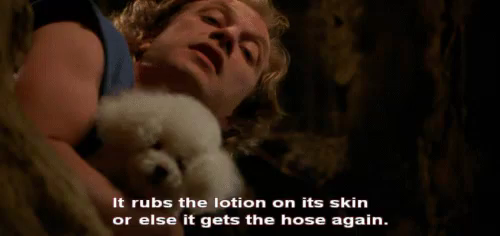

Imagine this: you get kidnapped and thrown into a pit. Your captor demands that you put lotion on your skin, or he violently hoses you down. But you blew off mobility and stretching on your recovery days and can’t reach your back to put lotion on it. Your only option now is to lure that damn little dog into the pit and use it for negotiating power. Stretching and mobility doesn’t seem like such a waste of time now, does it?
If you haven’t seen Silence Of The Lambs, that joke made no sense. Trust me; it was funny as hell.
All kidding aside, can you put lotion on your back? All of your back, including the area between your shoulder blades. If not, you have shoulder mobility issues. It’s the most straightforward test I know of. Most of us spend the majority of our day in a fairly limited position (i.e., seated at a desk), so don’t be surprised if you struggle to do this. The fix is pretty straightforward but requires commitment on your part. We’ll get into the details further below.
The reason you want to do this (aside from the scenario above) is limited shoulder mobility will cause injury. Without good mobility, you’re forced to compromise your form to complete certain tasks (like a pull-up, overhead squat, or even a push-up). Compromising your form will lead to injury, injury further compromises your form, and the circle spirals downward from there. It may not be necessary to you now, but when you’re older, getting that can of peas off the top shelf without pain will be a pretty sweet deal, or maybe picking up those grandbabies you’ve been waiting for.
Fix It
The fix is simple and only requires a few minutes from your busy day. I’ll step away from my desk several times daily and do the exercises below while thinking through a problem. Bam! Two birds, one stone.
Touchdown
The first exercise is much like signaling a touchdown. If you’re a Dallas Cowboys fan, a touchdown is when someone from your team takes the ball and runs it into the end zone. This is a common technique for scoring points and winning football games.
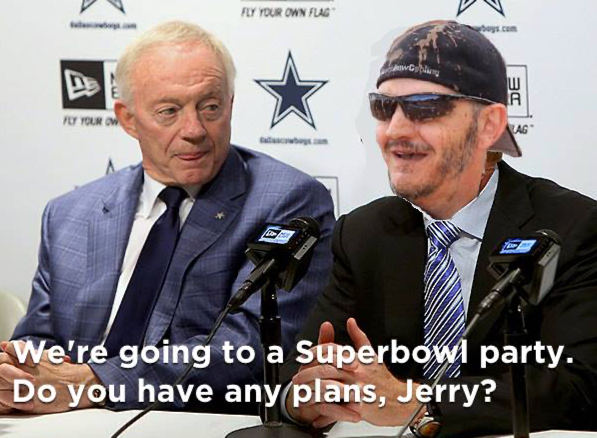

Stand facing the wall, just a few inches away from it. With your hands at your shoulders, slide your arms up the wall to signal a touchdown. Pull your shoulder blades together at the very top, causing your hands to come away from the wall. Slide your arms along the wall back down to your shoulders.
That’s one rep.
Repeat 20 times.
Move your arms slowly and feel the range of motion in each rep. This is not a WOD, be patient and deliberate.
Swinging Gate
Stand with your feet shoulder-width apart; arms stretched out front at shoulder height. Step back with your right foot, allowing your head and right arm to follow as if you were a swinging gate. Return to the starting position.
That’s one rep.
Repeat 20 times with your right arm, then 20 with your left.
Or do your left arm first, then right. I don’t care.
Pushups
Yeah, I know. Pushups. Do them anyway.
Pushups are great for shoulder mobility because pushing off the floor provides a stable base for strengthening your shoulder while increasing mobility (if done correctly). Aim for 10 perfect pushups. If that means from your knees, so be it.
Start on the floor with your hands just outside of shoulder width, thumbs slightly forward. Push using your chest and lats while keeping a tight core. No sagging, and unless you are going into a cocoon to become a beautiful butterfly, no caterpillar pushups.
At the top of your pushup, push higher to get a few extra inches out of the rep. During this stage, focus on feeling your shoulder blades move from your back to wrap around your chest. This is key. Most of us who are desk-bound have frozen shoulder blades, and this will begin the process of returning them to their natural, fluid state.
For extra mobility practice, do the pushups with different hand positions: wide stance, close stance, one forward/one back, fingers facing each other, and fingers pointing away. This changes the movement to get a full range of motion from the shoulder socket.
Today’s Tasks
Don’t forget to complete today’s tasks for the challenge.
- Drink 1 gallon of water
- Workout for 45 minutes
- Read ten pages from your book
- Stick to your meal plan
Once completed, head to the tracking site and mark them as completed to track your progress for the challenge. Tomorrow we’re going to talk about things that suck.
Embrace The Suck
Pain is real; suffering is optional.
A few years ago, I pinched the nerve in my neck that goes down the right side of my body. The weird thing about nerves is they don’t really know where the problem is. They receive an electrical signal from somewhere down the line. Usually, you receive a signal of pain from some part of your body. You look to see what is going on and notice blood coming from your finger. Your brain deduces that must be the source of the problem.
When nerve damage occurs, your brain receives signals, but there is no obvious sign of injury. As a result, it sometimes felt like my shoulder was torn. Other times I thought it was my elbow. Sometimes it felt like I had hurt my neck. The muscles would spasm consistently in response to nerve signals that weren’t there. These symptoms would alternate non-stop throughout the day. My doctor prescribed muscle relaxers, but they had no effect. Then he prescribed opioids, again with no change. Next, he prescribed anti-seizure medicine for epilepsy patients, again with no impact. Then I started taking all 3. Physically there was no change in my symptoms, mentally, though, I was a complete mess. It hurt to stand up. It hurt to lie down. It hurt to move my arm; it hurt not to move my arm.
Finally, in my daily reading, I stumbled across the phrase above pain is real, suffering is optional. I quit taking all of the medicine. Mentally I committed to not giving in to the pain. It was just an electrical signal, and I would treat it as such. When I moved my arm, I would not wince. I would not groan. It hurt, but that was merely an electrical sensation, and I would not allow it any more mental focus than flipping a light switch.
Things began to change after that. Physically, nothing was different about my injury, but mentally by refusing to give it focus; it became less obtrusive. One step forward, even if it is a small step. Eventually, I recovered physically but grew exponentially mentally, and that’s the lesson here.
Putting It To Practical Use
So how do we apply that story to honest, actionable advice that we can use?
First, when you’re deep into a demanding task, embrace the suck. Acknowledge the pain, but do not give in to the suffering. Pain is real, but suffering is self-imposed. Suffering can come in many forms: negative self-talk, groaning out loud, or closing your eyes to shut out reality. All these expressions reinforce the part of your brain saying, “I can’t.” Remember that when your brain says I can’t, you are only at about 40% of what your body is physically capable of.
Dear Negativity,
You are welcome to bitch, moan, gripe, complain, and voice your objection to the current situation. Understand that you have a voice here but don’t get a vote.
Sincerely,
Brain
Second, break your goals down into micro-goals. Instead of having a goal of doing ten clean and jerks, set a micro-goal of doing one. When that gets challenging, set a micro-goal of doing a clean, then another micro-goal of doing a jerk, then another micro-goal of lowering the bar. Always moving forward, even if measuring inches, not miles. Always forward, never back.
When the negativity sets in, remind yourself of the current goal and focus on that. Arguing with it, shouting over it, or trying to turn it off it doesn’t work. You can’t turn it off, but you can choose to focus on something else.
Never argue with an idiot. They will drag you to their level and beat you with experience.
One final note: use common sense. If you injure yourself during a workout, stop. There’s no glory in fucking up your body, even worse during training. There’s a difference between pushing through pain and trying to push through injury.
Under pressure, you don’t rise to the occasion; you sink to the level of your training.
–Navy SEALs
Today’s Tasks
Don’t forget to complete today’s tasks for the challenge.
- Drink 1 gallon of water
- Workout for 45 minutes
- Read ten pages from your book
- Stick to your meal plan
Once completed, head to the tracking site and mark them as completed to track your progress for the challenge. Tomorrow we will learn about visualization and how to use it for everything from minor tasks to major life goals.
Visualization
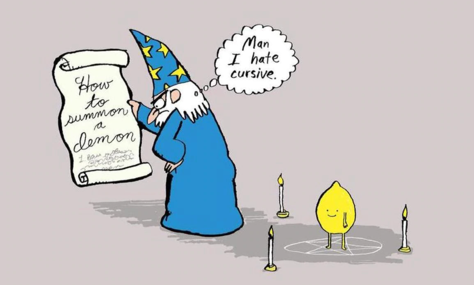

I’m straight up not gonna lie; visualization is a superpower, a magical spell, a gift bestowed from the Gods, and today I’m going to share with you how to use it in all areas of your life. But first: why does it work?
Stoopid Brain
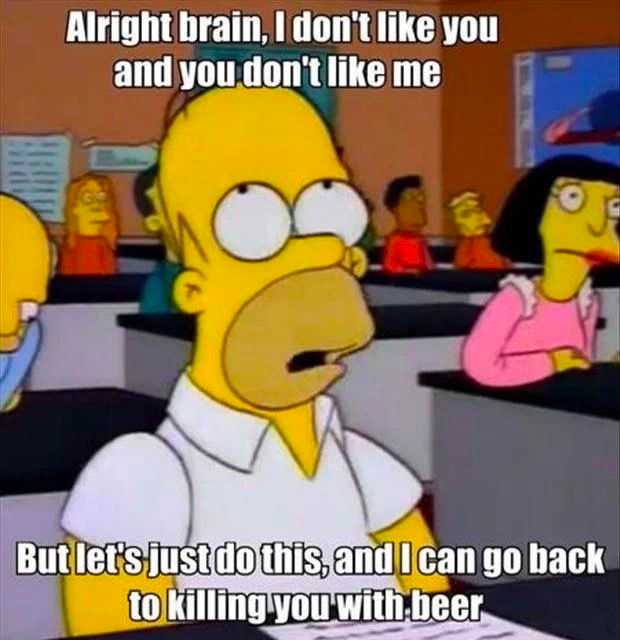

Your brain takes care of a lot without your intervention. Breathing, making your heart beat, regulating bodily functions, etc. It also is busy solving problems while you are focused on something else (think about those brilliant ideas you get in the shower). It’s also responsible for your dreams, fantasies, and even nightmares as it weaves various bits of data it has seen or heard about into a story.
Despite all the great things it does, it has one weakness: your subconscious brain can’t tell the difference between reality and fantasy. Only the outer layer of your brain can do that. And we can make this little piece of information work for us.
Setting The Stage
To take advantage of this, you need to visualize the thing you want to happen and you need to do so consistently with enough time for the changes to occur. For example, if your current deadlift is 200 pounds, rolling off the couch, brushing the Cheetos dust off of your gut, and visualizing lifting 500 pounds while reaching for the barbell isn’t going to work.
Sorry.
But! If you hope to do the Murph workout next Memorial Day full Rx with a weight vest: you’re in luck. Each day before going to the gym, spend 5 minutes visualizing that day. Imagine it in as much detail as possible: think about what the weather will be like, what you’ll be wearing, the music, and how excited you will be as you accomplish your goal. Engage as many of your five senses as you can. With consistency, your subconscious brain will not know the difference and assume that this is how it is. Your body will then start making subtle changes in how you perform to meet the expectations of what your brain believes to be true.
Put It Into Action
I won’t tell you what limits you can put on this (and you shouldn’t either). I will tell you, though, that you should be very specific. Don’t say “I want to be in shape”, say “I am at 15% body fat, back squat twice my body weight, and feel great.” Whatever you visualize has to be measurable so that your brain can accurately make the necessary adjustments. And again, when you say that statement to yourself, think about how you’ll look. Picture yourself doing the perfect back squat. Hear the sound of the PR bell as you ring it. Feel your gratitude and pride in accomplishing your goal as you see everyone congratulating you.
Where It Applies
You can use this in other areas of your life besides physical fitness. The only requirement is that you can visualize it. Money, food, fame, sex, it doesn’t matter. It also is highly effective at short-term tasks, such as your next 60 minutes of gym workouts.
Once you know what the WOD is, think about how you will do it. For example, let’s say there are back squats in the WOD. You hate back squats, and you suck at them. Period.
Well, that’s not an empowering thought.
Instead, acknowledge that you suck at back squats, then spend 5 minutes visualizing what you would look like doing the workout if you didn’t suck at them. Picture yourself doing perfect reps. Look at the plates on the bar. See how your chest remains upright, and your heels stay on the ground for every rep. Think about how these perfect back squats also improve other areas of your life. The more places in your life you can “hook” the visualization to, the stronger it becomes. Doing so instructs your brain on what the desired outcome should be. Pretty soon, your back squats will start to look like your visualization.
One more place you can use this: micro-goals. When under extreme stress, you can’t focus on big-picture goals. You have to break it down into something achievable. I used to be a 24-hour mountain bike racer. For 24 hours, I would ride up mountains, over logs, through mud and snow, and off cliffs. There are times during a 24-hour race when you can’t visualize the race ending. Instead, I would visualize the sun coming up and the warmth it would bring. I would visualize the daylight lighting the trail instead of my little headlamp. When that seemed too far away, I would break the goal down smaller: I would visualize making one perfect circle as my foot pedaled around the crankshaft.
Perfect circle.
Perfect circle.
Perfect circle.
It didn’t matter that my foot was attached to a carbon fiber crank arm that could do no shape other than a perfect circle. It gave my mind a task, a desired outcome, and a means to accomplish it. With that in place, I could keep progressing and do my job.
Put It To Use
Think about your goals. No, I mean seriously think about them. What does your life look like once you’ve achieved them? Visualize that and let your brain know what the desired outcome should be. It doesn’t matter what your goal is. It doesn’t have to be world peace or ending world hunger. It only has to be important to you.
Today’s Tasks
Don’t forget to complete today’s tasks for the challenge.
- Drink 1 gallon of water
- Workout for 45 minutes
- Read ten pages from your book
- Stick to your meal plan
Once completed, head to the tracking site and mark them as completed to track your progress for the challenge. Tomorrow we continue the impact of physical fitness on our lives as we talk about the negative side of physical fitness.
Your Wheelchair
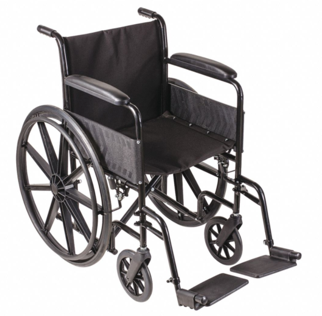

Here you go: go ahead and take a look. If you’re lucky enough, you will live long enough to need one of these. Have you thought about which kind you’d like? What features are important to you? Do you have a color preference? Leather seat or vinyl?
I get it. You probably haven’t given this much thought, and you may find this conversation a bit morbid and unsettling.
Instead of pretending this future doesn’t exist, ask yourself “how can I change it?” You may not be able to avoid it entirely, but you can nuance the details. For example, every day you train your mind and body, you push the day you inevitably need a wheelchair further into the future. This can be part of your “why” when you ask yourself “why am I going to the gym today?”
This concept continues a theme we’ve been exploring the last few days: the visual component of fitness may well be the least significant of all the reasons to be physically fit. For most of us, though, it’s the first (and sometimes only) thing we think of. The work you put into your body today lays the foundation for your fitness in the future. Your body is the ultimate retirement account. It’s the only place you have to live. You can’t start putting money into a 401k at 62 and hope to retire comfortably by 65. Investing for retirement works best when done in small, consistent increments throughout your life. Investing in your body works the same way.
If you’re lucky, you’ll live to a ripe old age. Aches and pains will increase, and mobility will decline each year. You need to hit them with as much momentum as possible to make the most of those years. The decline in fitness in your older years is going to happen regardless. Where you start the decline is entirely up to you.
Today’s Tasks
Don’t forget to complete today’s tasks for the challenge.
- Drink 1 gallon of water
- Workout for 45 minutes
- Read ten pages from your book
- Stick to your meal plan
Once completed, head to the tracking site and mark them as completed to track your progress for the challenge. Tomorrow, I’ve got a bonus challenge in store for you!
Giving Back
Today we are jumping the gun a bit and combining a physical component with being part of a community (which we’ll discuss
in more detail starting on day 36).
Are you as excited as I am? Probably not, but here we go anyway!
Inspired by Cranksgiving, you and your fellow participants in this challenge are going
to organize a race to collect items needed by a local charity. Here’s how it works:
- Contact a local organization such as a food bank, homeless shelter, retreat, or church and ask what items they need donated
- This list is given to everyone participating
- Pick a date, time, and location for the event
- You can choose your mode of transportation: bikes, skateboards, roller blades, or the ol’ shoe-leather express
- Race to see who can gather the items from the list the fastest from the most locations
- After everyone meets back at the starting point, decide on a winner (prizes are optional)
- Hang out, celebrate, reflect
- Donate everything collected to the chosen charity
This challenge carries multiple winning factors with it. First, it represents the need for real-world, functional fitness.
Looking good in a mirror does you no good if you can’t make tracks while transporting a turkey, baby! It also connects
you with the needs of your community, as well as a solution for solving that need. Finally, it connects you with other
people in your community in a way that brings you closer together and bonds you to a common cause.
If you try this, be sure to let me know how it went!


Today’s Tasks
Don’t forget to complete today’s tasks for the challenge.
- Drink 1 gallon of water
- Workout for 45 minutes
- Read ten pages from your book
- Stick to your meal plan
Once completed, head to the tracking site and mark them as completed to track your progress for the challenge. Tomorrow we are going to talk about caffeine. When should you use it, why you should use it, and how much is the right amount.
Caffeine- When Why, and How Much
Who doesn’t like caffeine, right? Most of us are fond of our caffeinated drink of choice and the rituals that go with it. Today we will examine caffeine’s upsides, downsides, benefits, and risks.
How Caffeine Works
Many mistakenly believe caffeine gives us the much-desired energy to power through our day. It’s the opposite effect. During your awake hours, your body produces adenosine. Adenosine then attaches to specific neural receptors, which signals our brain that we are getting tired. The caffeine molecule fits into those exact same neural receptors, blocking the adenosine molecules from attaching so our brain doesn’t get the “I’m tired” message.
How Much Is Too Much?
Ask most people how much caffeine they consume, and they’ll answer in terms of cups of coffee or the number of drinks. This is a meaningless metric, though. A cup of coffee, a Monster Energy Drink, and Red Bull all have different amounts of caffeine. Even a cup of coffee can vary from one cup to the next depending on where you get it, the type of bean used, etc…
The only accurate way to measure caffeine intake is in milligrams (mg). To calculate your daily caffeine intake, you must know how many milligrams of caffeine your favorite beverages have. Most Americans get the majority of their caffeine from coffee or energy drinks and not from soda, pop, or Coke (or whatever name you use, depending on what part of the country you are from).
So… how much is too much?
**The short answer is 400 mg per day. **
The long answer is (as always); it depends. Caffeine tolerance can vary widely from person to person. Trial and error is the only way to find out, but as a general rule no one should exceed 400 mg daily. One of the best indicators is your quality of sleep. Caffeine may be to blame if you don’t sleep well or are a light sleeper.
Maybe.
Sort of.
Not really.
This is one of those areas where there isn’t a lot of research to form a conclusive opinion. Some of the best studies have come from studying the impacts of caffeine on endurance athletes. Caffeine stays in your system for up to 5 hours, so they are the best candidates to benefit from and measure the effect of caffeine on performance. So what did the study show?
Ready?
A 1% - 3% boost in performance.
So if you qualify for an Olympic or professional-level event, 1% may mean the difference between first and second place. I could not care less about shaving 1% off my Murph time. I don’t even want to do the math to see how insignificant that would be.
The Benefits Of Caffeine
That doesn’t mean caffeine is entirely worthless, though. It just means that’s not the missing ingredient keeping me out of the CrossFit Games. Again, there is not a lot of research in this area, so all of these benefits come with the “early studies indicate…” disclaimer.
There’s a suggestion that people who consume more caffeine have a lower incidence of basal cell skin cancers. Caffeinated coffee is associated with a lower risk of diabetes and may be associated with a decreased incidence of Parkinson’s disease. There is also an association with a reduced risk of mortality. This doesn’t mean enough caffeine will make you immortal or prevent you from dying. Still, people who consume caffeinated coffee have a decreased risk of dying at any particular later age. Keywords: “lesser chance,” not “zero chance.”
The Risks Of Caffeine
Notice what I didn’t say in the section above. I said people who consume caffeinated coffee, not people who consume caffeine. Where you get your caffeine from makes a difference. Energy drinks are loaded with extra stuff you don’t need. Honestly, that is where the “energy” comes from, not the caffeine. As we learned in the beginning, caffeine doesn’t provide energy, it simply blocks the adenosine from attaching to the neural receptors to signal your brain that you are tired. Any energy boost you get comes from something else, and in the case of energy drinks: it’s usually sugar. The extra sugar can wreak havoc on your nutrition plan and thwart any goals you have in that area. For sugar-free energy drinks, you should ask yourself “what is in here that provides energy? Chemicals? Stimulants? Meth?


One of the other risks of caffeine is impacting your sleep schedule. Caffeine stays in your body for up to 5 hours, and the amount of caffeine needed to interrupt your sleep schedule varies wildly from person to person. If you want to sleep better, it’s worth experimenting with reducing caffeine consumption.
Increased anxiety is a considerable risk with caffeine and is not often discussed. Anxiety can come in many forms, and numerous factors can influence your anxiety. However, if this is an issue for you, much like sleep, it may be worth experimenting with reducing caffeine consumption.
And finally, the word no one likes to hear when talking about caffeine:
Addiction.
You don’t need me to tell you this: caffeine is addictive. I get it; the effects of caffeine aren’t even close to those of other addictive things like cocaine, meth, gambling, or tobacco. Odds are, you aren’t going to take up prostitution or burglary to finance your caffeine habit. But it is addictive.
Can you try going without coffee for a day? A month? Make yourself invulnerable to your dependency on comfort and convenience, or one day your vulnerability might bring you to your knees.
– Ryan Holiday
What bothers me most about caffeine addiction is the loss of control. I will schedule my day around fueling my caffeine fix.
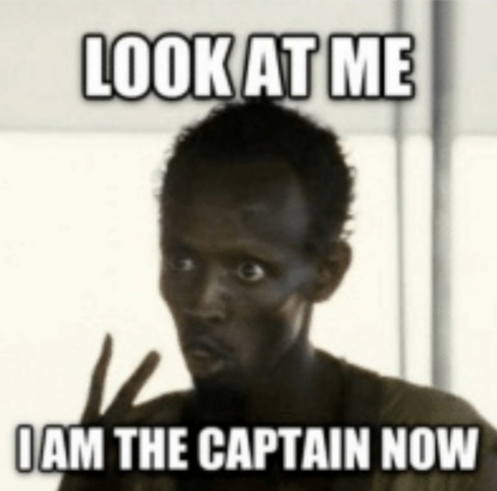

That pisses me off. I’m the Captain. I say when and where. And for that reason alone, I monitor my caffeine intake and frequently discontinue its use to prevent long-term addiction.
Take-aways
So, wrapping this up: the benefits of caffeine seem to outweigh any risks, but from a performance perspective, caffeine will not get you there. Take a day and record how much caffeine you consume and be mindful of that number. Consider eliminating caffeine for 30 days to break any dependency on it. Doing so is not as traumatic as you envision.
Today’s Tasks
Don’t forget to complete today’s tasks for the challenge.
- Drink 1 gallon of water
- Workout for 45 minutes
- Read ten pages from your book
- Stick to your meal plan
Once completed, head to the tracking site and mark them as completed to track your progress for the challenge. Tomorrow we’re going to tackle your annual physical.
The Annual Physical
Until a few years ago, my visits to the doctor were limited to events I couldn’t fix myself, like bones sticking out of the skin and such. I treated my doctor like a mechanic. “Fix it. Send me a bill. Don’t give me any of that scheduled maintenance bullshit.”
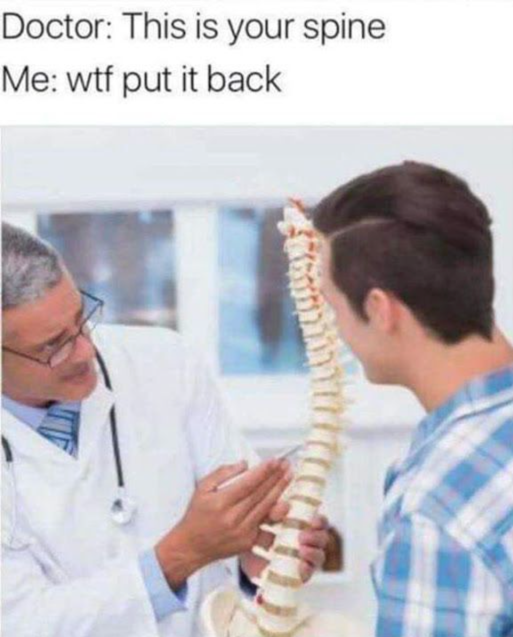

I went to the doctor to have some work done. It turned out the last guy I saw was no longer there. If all his patients were like me, he probably went broke and now works at Subway. The new doctor came in and started reviewing my records. “Jesus, dude. We don’t have any info on you…” I thought that was a compliment. (Hint: It wasn’t) The doctor then took the time to explain that things start to change as we get older. (I knew that already) But you can only identify that if you knew what the numbers were before the change. It’s like saying, “The car hit the wall and rolled away at ten mph". What was the speed before hitting the wall?
Kinda important.
The other key detail is that many standard metrics are specific to you. For example, my creatine levels indicate I have stage 3 kidney failure. I’m not, though; that’s just where my numbers are. The numbers used to identify different diseases and problems are based on averages across the population. By definition, average means that some people must be higher than the average number, and others must be lower. That’s how averages work, so you must visit your doctor annually for a routine physical.
It’s also helpful to build a relationship with your doctor. Tell them about what you do outside of your visit to take care of your health, like following a nutrition plan and working out. This helps them provide better advice to you. It also lets them know you are interested in your health and take it seriously. When things do come up (because they will), you’ll be better informed and prepared to deal with it.
The best time to plant a tree was 20 years ago. The second best time is today.
Today’s Tasks
Don’t forget to complete today’s tasks for the challenge.
- Drink 1 gallon of water
- Workout for 45 minutes
- Read ten pages from your book
- Stick to your meal plan
Once completed, head to the tracking site and mark them as completed to track your progress for the challenge. This email also wraps up our section on physical fitness. Tomorrow we start the next section: mental toughness.
Subsections of Mental Toughness
Mental Toughness
Today we start our section on mental toughness. The phrase can mean many things to different people, so let’s start by clarifying what it means to me and the topics we’ll cover over the next few days.
In a nutshell, mental toughness means resilience. It’s an uncompromising march toward your goals, with a refusal to give in to temptation or luck. This is best accomplished by creating habits. Once formed, habits provide consistent daily, forward momentum with no extra effort on your part. Another benefit of habits is a concept popularized by Tony Robbins called “stacking.”
Think back to when you learned how to drive. You had to operate the steering wheel, the gas pedal, the brake, and possibly the clutch. When you encountered an intersection, you had to find and use the turn signals (though some of us have yet to master this).


Over time, these independent actions became “stacked” into one task you now call driving. We can also leverage this same technique in other areas of our life to accomplish our objectives and goals.
That’s mental toughness.
It’s building those stacks so they become “what we do” without thinking about it.
“It’s raining and cold; why are you outside running?”
“I always run on Sundays…”
We’ll begin our section on mental toughness with morning and evening rituals. You’ll learn what they are, see some examples, and learn how to create your own. You’ve already started this process by building a daily routine around reading your ten pages, drinking a gallon of water, sticking to your meal plan, and updating the tracking spreadsheet.
From there, we’ll introduce meditation. Many struggle with this or assume it’s not for them since their goals don’t involve becoming a monk on a secluded mountain. We will break that myth and the myth that meditation means blocking all thoughts from entering your mind.
Goal setting will be our next topic. There is a saying “if you have no destination, any direction will do.” You do have goals, but you may not have articulated them or even thought of them as goals. We’ll define real-world, achievable goals and learn to put them into a context that is meaningful to you. Goals don’t have to be becoming a millionaire, achieving world peace, or becoming president (though if you’re interested, we really could use some solid candidates…)
Next, with our goals in mind, we must acknowledge that there will be obstacles along the way. How we deal with those obstacles ultimately determines our success in achieving our goals. We will talk about getting comfortable with being uncomfortable, and I’ve got some really fun challenges to help with that.
Finally, we’ll wrap up the section with a segment on box breathing that helps center and focus you, and for many, it is easier than meditation because it is more structured. We’ll also cover sleeping: how to improve the quality and determine how much is needed.
That’s a lot to cover, and I’m looking forward to it. I hope you are too, but for now, it’s time to focus on our daily tasks. Head to the tracking sheet to mark them as completed once done, and tomorrow we’ll dive into morning and evening rituals.
Morning And Evening Rituals
Rituals.
Who doesn’t love them? The fire, the blood-letting, summoning of demons…
Oh, wait, wrong email list. My bad.
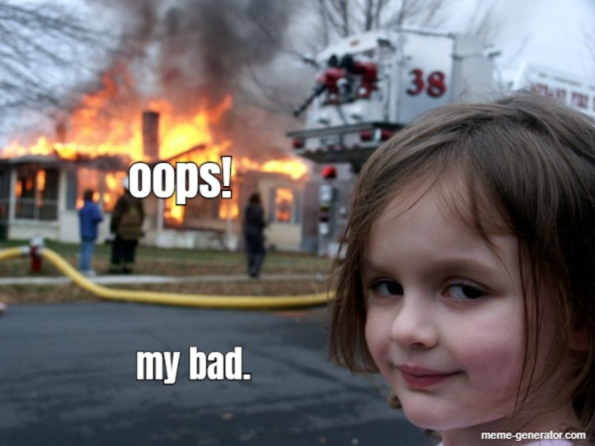

Defined
A daily ritual, simply put, is an activity or set of activities defined by you that you will not deviate from. This is commonly used to define your day or to work on the things that are most important to you. For most of us, our days are driven by distraction: your interrupting boss, a client that seems to have an “emergency” every day (side tip: fire these clients immediately), kids, school, spouses… the list goes on, but I don’t need to tell you that, right?
The point is there is always someone competing for your time. This can leave you feeling like you never have the opportunity to do “me” things or do the things that you know would ultimately improve the quality of your life.
Enter the daily ritual.
The daily ritual is time set aside, however much time you can, that absolutely, positively will not be interrupted. If God himself comes down from Heaven and demands your presence, he’ll need to have a seat, and you’ll be with him shortly.
It’s that important.
The time of day isn’t as important as having a defined time. For me, I use the early morning hours. No one likes to get up early, so my ritual time is almost guaranteed to be uninterrupted. If the evening or late at night works better for you, perfect! You can even change the time later if it’s not working for you; this isn’t an airline: there are no change fees.
Examples
Many admirable people have claimed their daily rituals are the keys to success.
Benjamin Franklin started his day at 5 am, asking himself “what good shall I do this day?”
Pablo Picasso locked himself in his studio to paint every day at 2 pm.
Mozart composed from 11 pm to 1 am every night.
Stephen King starts writing each day at 8 am sharp.
If it worked for them, it could work for us, too, right?
Objectives
There are several objectives with daily rituals:
- Identify the most important task of the day
- Build in time to work on that task
- Add structure to a chaotic life
Obstacles
A lot of people think they don’t have time for rituals. “My day is already busy; how can I add something else?” Many of you have commented on that as you struggle to finish your daily reading and workout. Here’s how:
For 24 hours, write down what you are doing every 15 minutes. It’s a shitload of writing; I get it. It’s worth it.
The next day, look at those tasks and ask yourself did this task improve my life? Ruthlessly eliminate anything that doesn’t. Granted, things like a job take a large chunk of your time, and you can’t do anything about that. But what about that half-hour you spent on Facebook, Instagram, or TikTok? What about Netflix?
Decide what is important to you and eliminate the rest.
You’ll feel better about it.
My Day
Here’s what my day looks like. Some days I deviate, but 90% of the time, this is it. There is no distinction between weekdays and weekends.
4:30 - 4:45 - I wake up, most of the time before my alarm goes off
15 minutes of gratitude & visualization using a Tony Robbins audio track
5:00 - 6:45 - gym/workout/stretching
6:45 - 7:30 - coffee, write in my journal, read my ten pages for the day, meditate, review my tasks for the day
7:30 - 8:30 - creative work. This is when I’m most creative, so I do things I want to do here. No client work allowed. Side projects or personal projects only (like writing 45 daily emails for this challenge)
8:30 - 12:30 - client or income-generating activities
12:30 - 1:00 - 20-minute nap
1:00 - 4:30 - client or income-generating activities
4:30 - 6:00 - dinner + cleanup + 1 episode of a tv show
6:00 - 8:00 - hobbies, leisure, projects: i.e., whatever I want
8:00 - 8:30 - review the day’s progress, set tasks for tomorrow
8:30 - all electronics off, stare into the abyss, self-degradation over my inability to spend 30 minutes without electronics
9:00 - bedtime
Ok, so that’s pretty regimented… but yours doesn’t have to be. Start small and make adjustments as you go.
Ben Franklin’s Day
I’ve been reading Ben Franklin’s Autobiography. In it, I found his daily ritual plan and thought it worth sharing here:
5:00 - Rise, wash, and address
6:00 - Powerful Goodness! (exclamation point his)
7:00 - Contrive the day’s Question: What good business shall I do this day?
Resolution of the day
Prosecute the present, study, and breakfast
8:00 - Work
12:00 - Read, or overlook my accounts and dine
2:00 - Work
6:00 Put things in their order.
Question: What good have I done today?
7:00 - Supper
8:00 - Music or diversion or conversation
9:00 - Examination of the day
10:00 - Sleep
Today’s Tasks
Don’t forget to complete today’s tasks for the challenge.
- Drink 1 gallon of water
- Workout for 45 minutes
- Read ten pages from your book
- Stick to your meal plan
Once completed, head to the tracking site and mark them as completed to track your progress for the challenge. Tomorrow we’ll introduce meditation and bust some mega-myths about why you can’t do it.
Meditating (How-to)
The Sole Purpose of Meditation
Think about this: suppose you are at work, diligently focused on your task, when a co-worker pops in to ask a question. You stop what you are doing to answer the question, but once complete, what do you do?
Do you return to your task or say “f**k it, I’ve been interrupted; I can’t go back to work now!”
Most of us return to our task, but when it comes to meditation, we assume that if a random thought pops into our mind, the whole meditation is ruined.
Nothing could be further from the truth.
If you get nothing else out of this section, understand this: meditation is not about clearing your mind of random thoughts, it’s about recognizing those thoughts and saying, “That’s not what I’m focusing on now.” When first starting to meditate, you may run with a thought for a full 10 minutes before recognizing you’ve been distracted.
That’s ok.
Meditation’s sole purpose is to recognize that you’ve been distracted. Whether that takes 5 seconds, 5 minutes, or 5 hours is irrelevant. Your incessantly chatting monkey mind is the annoying coworker to your meditation. You don’t have the authority to fire this coworker, but you do have the authority not to give it your attention.
No one, absolutely no one sits through an entire meditation session without letting their mind run off with a random thought. Let’s suppose such a person did exist, though, a Tibetan Monk able to keep their mind clear for hours at a time. You both sit down to meditate for 10 minutes, and at the end, you’ve caught yourself multiple times getting distracted while they maintained their focus entirely. It could be argued that you got a better workout because you did more reps. You exercised the part of your brain that identifies random, non-productive thoughts more than they did.
Why Meditate At All
Who cares?
We’ve already established that your meditation will always be filled with identifying and redirecting random thoughts, so why bother?
Let me ask you this:
Have you ever said something stupid you wished you hadn’t as soon as the word left your mouth?
Have you ever been in a disruptive environment where you wished you could have 5 seconds to think?
Have you ever struggled to think through a difficult situation with focus and intent?
I’m betting the answer to at least one of those questions is “yes,” and that’s where meditation helps.
It buys you space. Meditation trains the mind to identify and ignore random thoughts and refocus on the task. After all, random thoughts are just rogue electrical impulses in the brain, much like static electricity on a cold, dry winter morning. They appear they get your attention, then you refocus.


Meditation has health benefits as well. Meditation can help lower blood pressure, reduce anxiety, decrease pain, ease symptoms of depression, and improve sleep. So now the big question: how do I meditate?
How To Meditate
First, you’ll need a large robe, preferably dark red or burgundy, a mountaintop retreat, and a signature chant phrase from a spiritual leader at the quest’s end. Shaving your head is optional but highly recommended.
I’m kidding, but that’s how I viewed meditation before beginning the practice. There are multiple types of meditation and multiple ways to meditate. I’ll explain the common ones here, or if you’re impatient, skip to the bottom for the TL;DR (Too Long, Didn’t Read).
Focused Meditation
Focused Meditation involves using any one of the five senses. It most commonly involves focusing on the breath: feeling your belly expand on the incoming breath, feeling it collapse on the outgoing breath. After a few breaths, you’ll realize that you are no longer thinking about your breath and that your mind has run off in some random direction. That’s ok: drop the thought and return to the breath.
Movement Meditation
Movement Meditation uses gentle forms of movement to focus your mind. Yoga is a popular example, but it can also be done with walking, qigong, or musical instruments. I’ve been using this one recently with my guitar. I’ll pick a piece of music and play it from memory or sight reading. Sure enough, as soon as my mind wanders to something else, I start missing notes. This has been helpful because the incorrect notes provide immediate feedback that I’m not focused.
Mantra Meditation
This is what I perceived as meditation before learning differently. It’s the “Ooooooohhhhmmmm” meditation. It’s commonly used in Hindu and Buddhist traditions. It uses a repetitive sound (“ohm”) to clear the mind.
Spiritual Meditation
Prayer, anyone? A deep prayer is a form of meditation. Think about it: during prayer, you are deep in thought and highly focused on connecting with your spiritual being of choice. When random thoughts appear, you shove them aside and resume your prayer.
I’ll be damned; that sounds like meditation to me!
Transcendental Meditation
Just don’t.
You may be shocked that I have pretty strong opinions on some things.


Transcendental Meditation is the Pyramid Scheme of Meditation. It does have positive benefits, and it works… but.
Search for it on Google, and you’ll end up in a quagmire of “Transcendental Meditation introduction” centers that offer to help you with the process. For a fee, they will “help” you get started and “learn more about you” to identify the “perfect” mantra for your meditation.
Here’s the ugly truth they don’t want you to know: they have a spreadsheet of mantras and randomly give you one from the list once your credit card charges successfully.
TL;DR
“Cool story, bro. Just answer the question.
Use [Headspace] or [Calm]. They both have free versions and are available on iPhone, Android or from your computer. I’ve used both successfully for years and have nothing negative about either. Both have a “getting started” track to help further clarify the points I’ve made here, namely, “Yes, you’re gonna get distracted, and yes- that’s ok.”
Today’s Tasks


Look at that! We get to add another task to our daily task list! Starting today, we’re adding meditation to the list. It doesn’t have to be a marathon 4-day fast + meditation from a remote mountain top —just 10 minutes. And if you spend 9 minutes, 45 seconds of those 10 minutes wondering if you’ve ever bought milk from the same cow twice, that’s perfectly ok.
- Drink 1 gallon of water
- Workout for 45 minutes
- Read ten pages from your book
- Stick to your meal plan
- Meditate for 10 minutes
Once completed, head to the tracking site and mark them as completed to track your progress for the challenge. Tomorrow we will talk about goals, but avoid the self-help guru bullshit that usually accompanies it.
Goals
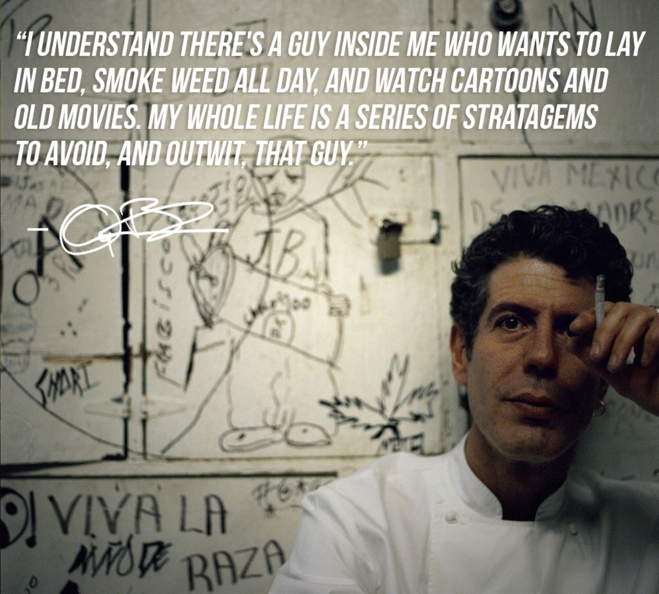

We will talk about goal setting today, but I will avoid the happy, wishy, manifesting, fairy tale bullshit that most goal-setting gurus preach. If you’re looking for that, plenty of resources are available for you elsewhere. For me, most of my goals resonate with the photo above: keeping one step ahead of Will to keep Will from fucking up Will’s life.
Our focus here is on goal achievement, not goal setting. It’s a subtle but key difference. It doesn’t matter what your goals are, and I know you have them; you may not think of them as such. Losing weight, doing a strict pull-up, getting a new job, buying a home, and getting a new relationship all count as goals. So what are the key components that distinguish goal setting from goal achievement?
Clarity, specificity, balance, and time.
I asked the Genie for $1000 per day for the rest of my life.
He handed me $3000 and wished me luck.
Clarity
It’s important to be clear on what the “goal” of this goal is. If your goal is to make more money, why is that important to you? What problems in your life will be solved by having more money? What additional problems will you have as a result of having more money? It’s important to think these through to ensure you’re chasing the right goal. Oftentimes, we spend a tremendous amount of effort chasing a goal that could have been more easily obtained by clarifying the end result in the beginning.
For example, if your goal is for more money, why?
Because having money means freedom.
What is freedom?
The ability to do what I want, when I want.
What do you want to do that you currently can’t?
…
Continue this process until you are very clear on what your actual goal is. It may take days or weeks to work through this process. That’s ok; you’ve got your entire life.
Once you’ve clarified your goal, it’s time to get specific.
Specificity
What will your life look like when you achieve your goal? Be as specific as possible here. Imagine what a day in your life will look like. If your goal is a specific event, imagine what the weather will be like. Feel the sun or rain on your face. Who is there with you? Picture their faces. What are you wearing? What can you smell? What do you hear?
The objective here is to engage as many of your senses as possible, to build a realistic picture of what achieving your goal looks like. Each of your senses is controlled by a different part of your brain, so by tying your goal to multiple senses, you actually store your goal in multiple parts of your brain. Think of it like saving a document to the hard drive on your computer, then putting another copy on a USB stick, copying it to your Dropbox account online, then emailing a copy to yourself, all to ensure that you don’t lose this document. When you engage all of your senses, your brain starts to get the idea that whatever this is, it must be really, really important.
And then, we have to consider the other parts of our lives.
Balance
In my experience, this has been one of the major causes of failure for my goals in the past. We often set a goal but fail to consider its impact on other areas of our life. For example: making more money. It can come in the form of a new job that requires long hours. Those long hours mean less time with our family, skipping days at the gym, and possibly eating less healthily because we are always at the office (assuming this goal takes place in a non-pandemic environment where interaction with people is allowed 🤣).
Thinking about your goal’s impact on the rest of your life allows you to overcome these obstacles before they become problems. It may cause you to rethink your goal entirely, or it may cause you to add more clarity to your goal. For example, a new job involves longer days at work. To prevent sacrificing quality time with your family, you set up a specific time dedicated to family time each week, and everyone participates. To avoid missing the gym and sacrificing your fitness, you get up at 4:30 am to work out before you start your day. What are the major areas of your life? Well… they happen to be represented by the five spinning plates we cover in this challenge: nutrition, physical, mental toughness, community, and financial.
Getting up at 4:30 may sound horrible to you right now. But if your goal is big enough and important enough, you’ll find that you actually look forward to it. Each morning when you wake up, you’re energized and excited because this is the path to your goal, and everything that achieving your goal brings with it.
Time
Achieving your goal requires an ongoing time commitment from you, and not in the way you think. Sure, if your goal is to lose weight, there is a time commitment to the gym and preparing food, but there is an additional time commitment to maintaining and grooming the goal. Review what you’ve read here today: the time it takes to clarify your goal. The time it takes to make your goal specific. The time it takes to balance your goal with the other areas of your life. And you can’t do this once and forget it. You need to write your goal down.
Every.Fucking.Day.
Never allow your brain to second guess if this goal is still relevant. Write it down daily to tell your brain it is. Incorporate this into your morning or evening ritual. If you’re not committed to doing this, you are likely working on the wrong goal.
Today’s Tasks
Don’t forget to complete today’s tasks for the challenge.
- Drink 1 gallon of water
- Workout for 45 minutes
- Read ten pages from your book
- Stick to your meal plan
- Meditate for 10 minutes
Once completed, head to the tracking site and mark them as completed to track your progress for the challenge. Tomorrow we will talk about the tasks you do each day, specifically how those tasks relate to the goals you’ve identified today and how to approach those tasks with intent.
Exactly What You Need
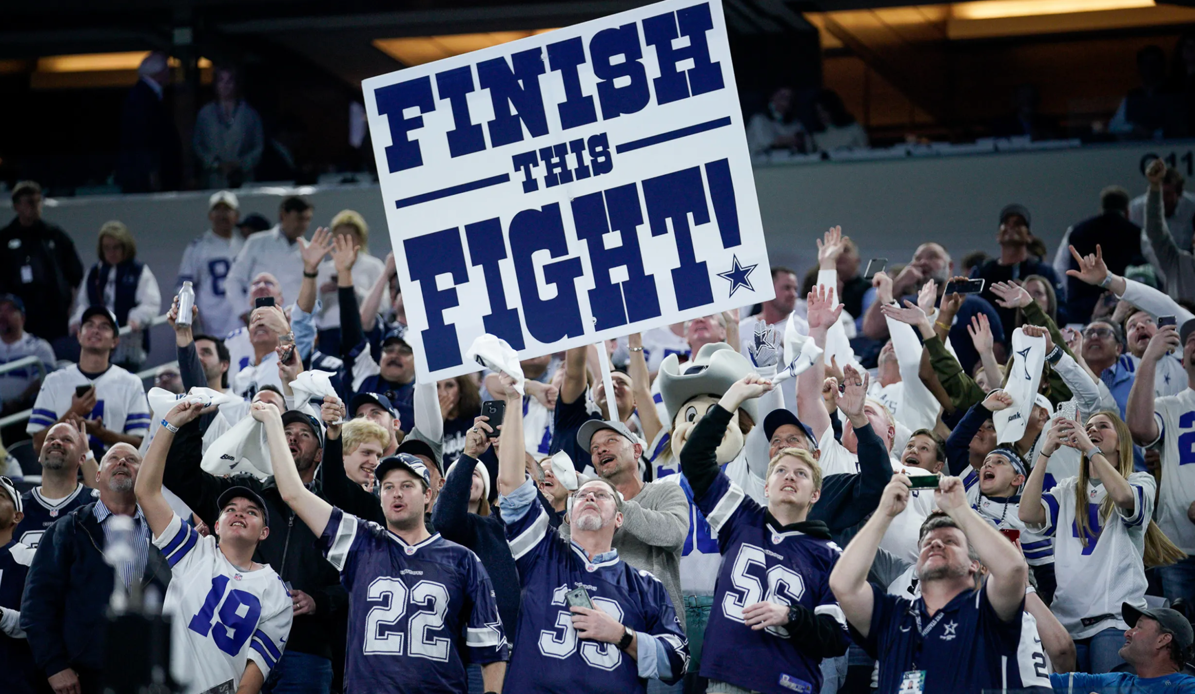

You keep using that word. I do not think it means what you think it means.
– Inigo Montoya, The Princess Bride
We’re down to two weeks left in this challenge. Maybe you aren’t seeing the progress you were hoping for. Maybe you skipped a few days and lost motivation. Maybe it hasn’t been what you were expecting.
It’s tempting to throw in the towel.
Maybe the next challenge will be better.
Maybe this isn’t for me.
Or, maybe, it’s precisely what you need. The temptation to quit is strongest just before the finish line.
The most critical reps for any exercise are the last two. In a set of 5 x 8 back squats, sets 1 - 4 and reps 1 - 6 of set 5 are just the prerequisites to get you to reps 7 and 8. Those last two reps are where the gains are made. This challenge is no different. We’ve covered nutrition, physical training, and mental toughness. All of it was designed to get you to this point. These last two weeks will define your success in the challenge.
If you’re struggling with one of your daily tasks, reflect on why. Dig in to understand the challenge with it, then create a plan to address it, but don’t quit. If you aren’t sure what to do, ask for help. Help can come in many forms, but no help comes if you don’t ask.
Adapt. Improvise. Overcome.
Finish this fight.
Setting Intent
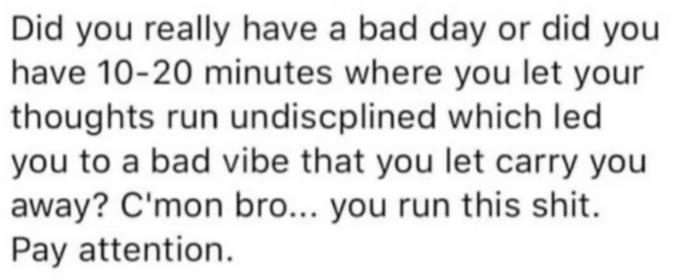

There’s a saying from Marcus Aurelius, “Joy for humans lies in human actions. Human actions: kindness to others, contempt for the senses, the interrogation of appearances, observations of nature and events in nature.”
I think it serves as a compass when pursuing your goals and setting the intent of your pursuit. When we set goals, we tend to focus on the end product: that moment when we achieve the goal, whether it be a week, a year, or a decade from now. Over time, you learn that it’s not really the goal itself that brings joy but the pursuit of it. To lose sight of that is to lose life in the days that pass between setting the goal and achieving it.
That’s where intent comes in. Make it your daily intention to pursue your goals and take joy in them. For example, if your goal is to back squat twice your body weight, make today’s intent to do your back squats with perfect form and deliberate action, regardless of the weight on the bar. This has the effect of funneling the joy awaiting you at the end of your goal to today. Even though your goal isn’t complete, you still get to partake in the feeling of completing it by taking deliberate action toward its completion.
This works for non-goal-related items as well. Throughout life, we all must do things we don’t like but are necessary. A recurring example for me is paying my quarterly taxes.
It’s amazing to see the number of bullshit, useless, trivial, non-productive tasks I can devise to avoid doing this. The task takes about 20 minutes, but I can spend weeks avoiding it. How can I set the intention of this task in a way that aligns with my goals?
First, I have to consider why I avoid it. The root cause is I’m horrible at accounting. I’m horrible at accounting because accounting, in a nutshell, is a disciplined process of categorizing money coming in and money going out.
I suck at this.
So, when my taxes are due- there has been a lot of money going in and out but not categorized, so now I have to look at each transaction and figure out where it came from or went.
The solution is straightforward: every time I make a transaction, I open the app on my phone and enter it. Do I do that?


So every quarter, I relish in self-degradation over my lack of discipline.
Discipline.
Wait… that happens to be one of my core principles. It’s something that I believe is a fundamental skill that I must possess and be proficient at. In some areas, I’m very disciplined. In others (like tracking my expenses), not so much.
So now, when I sit down to do my quarterly taxes, I specify the intent of this action is to work on a core principle: discipline. With this philosophy, I turn a dreaded task into an opportunity to improve a skill I value and consider essential.
TL;DR:
For every task you do in a given day, ask yourself how this task moves you closer to your goals of a well-rounded life. This applies to tasks you want to do and those you don’t want to do.
Today’s Tasks
Don’t forget to complete today’s tasks for the challenge.
- Drink 1 gallon of water
- Workout for 45 minutes
- Read ten pages from your book
- Stick to your meal plan
- Meditate for 10 minutes
Once completed, head to the tracking site and mark them as completed to track your progress for the challenge. Tomorrow we cover one of my favorite topics: getting comfortable with being uncomfortable.
Getting Comfortable Being Uncomfortable
Life can be uncomfortable at times. You might reflect on 2020 and agree. Consider Viktor Frankl’s life, though, in comparison. He spent three years imprisoned in Nazi concentration camps. His family had been killed. His life’s work was destroyed. His freedom was taken away.
How did he respond?
He discovered he had one thing that couldn’t be taken from him: his ability to determine what this suffering meant. From there, he found that he could find positives in this grim situation. He could test and revise his theories. He could be of service to others. He even took some solace that his loved ones were spared the pain and misery that he faced daily.
Find The Good
I’m not promoting some happy, hippy, peace and love bullshit here, but I am saying that we can use the lessons learned by those who have gone before us to our benefit. You choose how you feel about it in even the most dire situations. No one can force you to feel a certain way.
Hope Is Not A Strategy
We can all hope and take action to minimize our chances of ending up in a situation like Frankl did. In the end, that may not be enough. It may not be a concentration camp, but plenty of other difficult situations can and will arise: losing a loved one, destitution, cancer, disease, or war. How will you respond when disaster strikes?
Seneca said “set aside a certain number of days, during which you shall be content with the scantiest and cheapest fare, with course and rough dress, saying to yourself the while ‘Is this the condition that I feared?’” He lived according to that principal and would routinely live as a homeless person for a period of time to remind him that, if it happens for real, he will survive.
We can use this tool in our own life as well. One way to do it is to take away modern life’s comforts, such as hot water.
The Challenge
So today, I’m introducing a new challenge: take a cold shower. Between now and the end of the challenge, take a shower with no hot water for an extra 10 points in the challenge.
While doing so, pay attention to how your body reacts. Notice the negative self-talk and pay particular attention to all the creative stories your mind comes up with to get you to either not do it or stop it once you start. Harden your mind, body, and spirit by ignoring these thoughts and persevering anyway. Ask yourself “Is this the condition that I feared?”
Today’s Tasks
Don’t forget to complete today’s tasks for the challenge.
- Drink 1 gallon of water
- Workout for 45 minutes
- Read ten pages from your book
- Stick to your meal plan
- Meditate for 10 minutes
Plus, the bonus cold shower challenge.
Once completed, head to the tracking site and mark them as completed to track your progress for the challenge. Tomorrow I’ll introduce box breathing and show you how to use it to calm yourself, redirect, and focus.
When it comes your time to die, be not like those whose hearts are filled with the fear of death, so that when their time comes they weep and pray for a little more time to live their lives over again in a different way. Sing your death song and die like a hero going home.
– Chief Tecumseh
Box Breathing
Box breathing has been incredibly useful to me. Some days, it’s hard to calm the mind during meditation. Other times, I find myself needing a way to gain control of my mind while sitting in the doctor’s office, waiting for an important meeting to start, or driving. Box breathing provides more structure than focused meditation, keeping my mind from racing off but still providing the same benefits.
How To Box Breath
Box breathing is as simple as it sounds. Imagine a box viewed from the side- it has four equally sided-squares:


- Breathe in through your nose while silently counting 5 seconds
- Hold that breath while counting another 5 seconds
- Exhale slowly through your nose, you guessed it: for another 5 seconds
- With empty lungs, count the final 5 seconds
- Go back to step one, repeat for 5 minutes
The How and the Why
Evidence has shown that box breathing can calm and regulate the autonomic nervous system, which runs our automated functions, like pumping blood and regulating our body temperature.
The slow breathing introduced by box breathing allows CO2 (Carbon Dioxide) to build up in the blood. The buildup of CO2 triggers a cardio-inhibitory response of your vagus nerve. A build-up of CO2 usually indicates that your body is working hard and using all of the oxygen available, so the parasympathetic nervous system kicks in and sends signals throughout your body that everyone needs to chill out and stop burning so much energy.
The end result is a feeling of calmness and relaxation. This reduces stress and can improve your mood. Box breathing is an exceptional treatment for anxiety, panic disorder, PTSD, and depression. It can also help with insomnia by calming your nervous system before bed.
Box breathing is also effective at pain management. This works for two reasons: first, it calms your nerves, body, etc. Second, it takes mental focus to perform, which diverts your attention from the pain to the counting of the breath. After all, pain is nothing more than an electrical signal to the brain. So by giving the brain a different job, we can control the pain level.
Advancing The Practice
There are a couple of things to know about box breathing before starting:
- You may get dizzy. Depending on your oxygen levels, focused breathing may increase the level, resulting in feeling dizzy. This is ok. Over time, this will go away. When it happens, it’s ok to pause the exercise for a few breaths, then resume.
- You may feel like you aren’t getting enough air. Most of us don’t practice holding our breath; for some of us, even holding our breath for just a few seconds can trigger the fight or flight response for air. I encourage you to ride this out. It’s mind over matter. If this happens, focus on the following:
- You know the next breath is seconds away. Nothing is preventing you from breathing
- You can go 4 minutes without air. We’re just aiming for 30 seconds, so… chill. (Note: I didn’t say it would be a pleasant 4 minutes; I just said that’s the upper bounds of the physical limit)
- This is mental training. Use this as the opportunity to command mastery of your mind.
- Absolute, positively, worst-case scenario: what could happen? You pass out. What happens when you pass out? You stop holding your breath and start breathing. #problemsolved
- As your lungs get more efficient (you’ll notice this in your workouts), you can try increasing the count from 5 to 6, 7, or as high as you feel comfortable.
- For variations and taking the practice further, look into Pranayama Breathing.
Today’s Tasks
Don’t forget to complete today’s tasks for the challenge.
- Drink 1 gallon of water
- Workout for 45 minutes
- Read ten pages from your book
- Stick to your meal plan
- Meditate for 10 minutes, or 5 minutes if using the box breathing technique
Plus, the bonus cold shower challenge.
Once completed, head to the tracking site and mark them as completed to track your progress for the challenge. Tomorrow, it’s sleepy time.
Sleep
It’s important.
Great. Glad we had that chat. I feel better.
If you struggle with sleep, it sucks. It can get better, but there’s no magic cure. When your sleep finally improves, it will result from many trial-and-error sessions to identify the right conditions for you. That’s a common theme throughout this challenge: for you. No one can give you the perfect nutrition plan, fitness program, meditation path, or financial strategy. What works for someone else may be the worst possible solution for you.
The only way to figure it out is through trial and error.
Sorry. There are no magic bullets, and sleep is no exception. There are some common starting points, though.
Making Changes
When making changes to your lifestyle to improve your sleep, trying something for one night isn’t going to cut it. If you are sleep-deprived, it may take weeks to recover enough to notice a difference in your sleeping habits. The key to successful changes is to make one change at a time and try it for two weeks before reaching a conclusion or trying something else. Make sure you document the changes you make and make daily notes to track how you feel when you wake up and throughout the day.
Caffeine
We discussed this in the section on caffeine, but it’s worth repeating here. Caffeine can and will impact your sleep. Caffeine takes up to 5 hours to pass through your system, and a long-standing relationship with caffeine (a.k.a. addiction) may impact that even more. But, if you’re not sleeping well and waking up rested, refreshed, and ready to start your day: this is the first thing that must go.
Duration
Here’s the weird thing about sleep: we do it in cycles. There is a period when you first fall asleep where transition from wakefulness to sleep. Then you go into a period of light sleep before entering deep sleep. Next, you go into a deep sleep, the kind of sleep that leaves you feeling refreshed in the morning. Finally, there is the type of sleep most of us have heard of: REM sleep, when most of your dreams take place.
The interesting part is that this isn’t a linear process; ideally, you go through each cycle multiple times per night. The duration of each cycle is also different from individual to individual but usually consistent for the same person.
Who cares, right? Well, you do if you’re sleeping poorly, and here’s why: Ideally, you want to wake up at the end of the cycle. If your alarm is set to go off right in the middle of your stage 3 deep sleep, you will feel terrible waking up. The entire sleep cycle ranges between 3 - 5 hours for each person, with 4 hours being the average. So, the recommended 8 hours of sleep results in 2 complete cycles for the average person.
If that’s not working for you, try getting 7 hours of sleep, 9, or whatever variation is needed to find your ideal number. But that requires falling asleep promptly, right?
Falling asleep quickly
Tossing and turning for an extended period of time can be frustrating at best. To maximize your chances of falling asleep quickly,
- eliminate all caffeine 5 hours before bedtime
- no electronics 30 minutes before bedtime
- take a warm shower/bath before bed
- lower the temperature and lighting in your bedroom as much as you can
Look at this article for tips on how to fall asleep in 2 minutes or less.
If all of that fails, get the f@$k up. Don’t allow your bed to be turned into a pity zone. If you can’t fall asleep, get up and leave the room. But here’s the deal: don’t mindlessly watch TV or scroll through Instagram. Do something productive and useful with your life: read a book, work on your goals, plan a trip (even if you’ll never take it), get started on tomorrow’s tasks, or do anything to make your brain work. When you get sleepy, go to bed.
Tomorrow morning when the alarm goes off, get up. Sure, you’re going to be sleepy. Get up anyway. Doing so will ensure you’ll be ready when bedtime comes around tonight.
Polyphasic Sleep
If you’re adventurous, you may want to experiment with polyphasic sleep. Polyphasic sleep involves spreading your sleep schedule throughout the day. Word of warning: this is for the seriously committed only. To succeed, you must stick to it and completely control your time throughout the day. I did this a few years ago when I needed more time in the day. There are different schedules, but I went with a 20-minute nap every 4 hours and a 2-hour nap at 2 am. I’m not sure how long I stuck with it. Time loses meaning in this plan. But as far as being productive: it was a huge success. The main reason for not continuing this plan for longer was its impact on my social and family life. If you’re interested, research polyphasic sleeping or hit me up for details on how my experiment went.
Today’s Tasks
Don’t forget to complete today’s tasks for the challenge.
- Drink 1 gallon of water
- Workout for 45 minutes
- Read ten pages from your book
- Stick to your meal plan
- Meditate for 10 minutes, or 5 minutes if using the box breathing technique
Plus, the bonus cold shower challenge.
Once completed, head to the tracking site and mark them as completed to track your progress for the challenge. Tomorrow, we move into the final section of our 45-day challenge: Community.
Subsections of Community
Introduction
What do we mean by “community”? It has become a lost word in the modern age of social media. But that’s actually why I included it in this challenge. Digital communication can’t replace human interaction.
First, most of us aren’t as good communicators as we think. Combine that with the fact that most communication comes from body language and tone of voice, and we’re limiting our ability to communicate.
On top of that, let’s add some controversial topics…
It’s a recipe for failure.
So, over the next few days, we’ll cover some topics that remind us what it means to be a community member, hopefully, learn some new skills, and maybe break out some older ones that we haven’t used in a while.
Showing Up
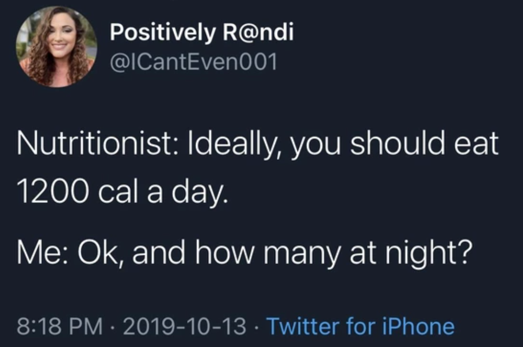

All of us have a shared common interest in CrossFit. It’s how we know each other and have found additional common bonds through that. Stepping back for a minute, though, why did we start doing CrossFit?
To get into shape. To improve our fitness.
So CrossFit is great for that, right? Sort of, but CrossFit’s not responsible for the success.
The reason CrossFit works has absolutely nothing to do with Murph, Fran, squat snatches, burpees, or Greg Glassman.
It’s not about the workout.
You show up to class. We all do the same workout. We all suffer together. Suffering together forms bonds of friendship. So now, when you skip class, you feel guilty. Your friends are in the gym suffering, and you’re not.
Guilt forces you to go to the gym.
Going to the gym leads to consistency.
Consistency leads to results.
We could be doing Jane Fonda workouts in the gym, and it wouldn’t matter. The results would be the same.
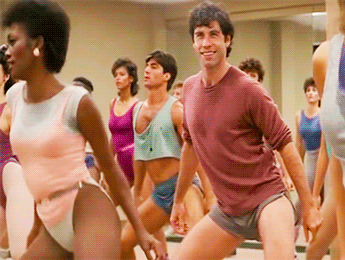

Social media tools like Facebook, Instagram, Snapchat, and others have been a great way to reconnect with old acquaintances, stay in touch with friends both near and far, discover topics of interest, and join pyramid schemes. It hasn’t come without a cost, though. I’ve spent a fair portion of my career interacting with this industry, and we’re learning that the cost is much higher than bargained for.
The downside is that these tools sandbox us into beliefs that do not reflect reality. They are designed to show us what we are looking for, which provides a false sense of reality. Many like to vilify the creators of these tools, but that is not the case. It’s the classic story of death by 1,000 cuts. Running a company like Facebook requires millions of dollars per month to power the hundreds of thousands of servers throughout the world that make it work. TL;DR- those servers aren’t free. How much are you paying for their service?
If you aren’t paying for it, you’re the product.
A key point to understand is how these companies make money (and must make money, or they go out of business). As you scroll through your timeline, you see a mix of posts from your friends and posts from advertisers. The advertisers pay to put their posts on your timeline; your friends don’t. The standard metric determining success is the amount of time you spend in the app. More time in the app = more ads = more revenue, so the algorithm is constantly being tweaked to keep you engaged with the app. Everything you do within the app is measured. If you pause on a post while scrolling, it’s measured. If you scroll back up to a post, it’s measured. Even if it’s something you disagree with. These metrics are combined to find and display similar posts to keep you engaged.
This becomes problematic when you see a post that really pisses you off. This is common on social media, where people can say things they wouldn’t say in real life.
Everyone has a plan until they get punched in the face.
– Mike Tyson
You pause. You read it. You vent your frustration about it. God forbid if you comment on it. Now your timeline rapidly fills up with similar stories. You see one story after another on this topic. With this many stories on the subject, this must be a huge problem.
Not necessarily.
It’s just the result of a computer algorithm mimicking the behaviors you’ve trained it to perform. Unfortunately, this has already impacted your views and beliefs. You’ve now seen sufficient evidence that this thing must be true. It impacts your mood, conversations with friends, and actions in the real world. The damage has been done.
You can’t unring a bell.
– Larry Goins
So how do you combat this?
The first step is to restrict your time spent on social media. Use it as needed, but no more.
Second, understand that social media is not reality. Remember the National Enquirer tabloids from decades past? Yeah- that’s exactly how much credibility things you see on social media deserve. Rank anything you read right next to Bigfoot spotted riding the Lochness Monster in the Wal Mart parking lot.
Third, rule #2 applies to all sources of data. That includes posts from organizations that you would assume are credible. The more credibility you give them, the less they likely deserve it. Remember, they are all in the business of luring you to their website to show you ads that make them money. Truth is not the metric; the number of clicks is.
Finally, understand it’s not a conspiracy. It is a platform that has spiraled out of control because we didn’t understand the implications of it. Although we’ve seen the full scope of our actions, unraveling it isn’t as easy as we’d hoped. Entire companies and, by proxy, the livelihood of millions of families employed by these companies now depend on the revenue generated.
Safeguard your mind and the information you allow into it. Exercise the same principle you use to safeguard your home, car, and family. If this topic interests you and you’d like to learn more about it, Netflix has a great documentary on the subject [here], or you can talk to me about it… just not on social media. 🤣
Today’s Tasks
Don’t forget to complete today’s tasks for the challenge.
- Drink 1 gallon of water
- Workout for 45 minutes
- Read ten pages from your book
- Stick to your meal plan
- Meditate
- Hit that cold shower, there are still a lot of boxes to check there, and the weather (along with the water) is only getting colder!
Once completed, head to the tracking site and mark them as completed to track your progress for the challenge. Tomorrow’s topic: No.One.Cares.
No One Cares
How much weight did so-and-so put on the bar?
What’s their PR?
Who Rx’d the WOD?
It doesn’t matter.
Sometimes we’re tempted to measure ourselves by others. This applies not only to our workouts but to other areas of our life as well. We define success by the achievements of others. While that’s ok when looking to see what may be possible, it’s important not to fall into the trap of thinking that others judge us by the same criteria. Here’s the magic secret:
No one cares.
Most people aren’t even looking. They are focused only on their own efforts and battling their own demons. That’s not to say everyone is self-absorbed. Sure, some people are, but that’s not our problem. The problem is when we beat ourselves up over metrics that don’t matter. It’s almost impossible to judge yourself based on the accomplishments of others because we all start at different points.
If two people became millionaires, but one started with $999,999, it’s not a fair comparison. When setting standards for yourself, use universal metrics: did you give it your all? Were your actions just and true? Was it better than yesterday, even by just 1%?
Just that you do the right thing. The rest doesn’t matter.
– Marcus Aurelius
When you stop comparing yourself to others, you will find a great weight has been lifted off your shoulders. With this weight removal, you find freedom, flexibility, and control. It frees you to the point where you can finally see what you are capable of.
Today’s Tasks
Don’t forget to complete today’s tasks for the challenge.
- Drink 1 gallon of water
- Workout for 45 minutes
- Read ten pages from your book
- Stick to your meal plan
- Meditate
- Hit that cold shower if you haven’t yet!
Once completed, head to the tracking site and mark them as completed to track your progress for the challenge.
Legacy
How much time and effort do you put into building your legacy, whether large or small? Setting aside money for your children’s future? Preparing them for life after your death? Working long hours to ensure your business remains long after you cease to?
How rewarding is it for Thomas Edison that on this day in 1879, he demonstrated the first electric lamp, which has changed our lives dramatically since? It’s not.
He’s dead.
He has no idea, and neither will you. Instead, how rewarding is it to call your neighbor for coffee or meet with friends for dinner? How rewarding would it be to take the afternoon off to help clean up the Parks and Rec center, make sure your neighbors have a ride to the polls on election day, or organize a family dinner with no cell phones, tablets, or tv? It’s rewarding right now, in the present. And really, the present is all there is.
Memento mori.
You could leave this life right now.
Write Your Own Obituary
Most laugh when I tell them to do this. “That’s crazy, bro. It’s written by someone else after you die.”
Yeah. Most of the time it is, because the person who died didn’t do it. But think about this: you just died and now you’re
pinning the responsibility of writing your own obituary on those currently struggling with losing you (hopefully)?
There’s another reason to write your own obituary too: it’s your last chance to leave everyone your final thoughts. It’s
an opportunity to tell those you love how much they meant to you.
It’s one last chance for you to step up as a leader and tell them that it’s going to be ok.
My obituary is in a sealed envelope in our home, to be opened if I die. I also have a digital copy on my laptop and a
reminder each year to review it. Sometimes there are new things I’d like to say. Sometimes there are things that should be
left unsaid.
The final thing I’ll say on it is this: it’s for you, too. Sitting down to write it is a sobering experience. Were you
the person you wanted to be? If not, what better time to find out than while you’re still alive and can do something about it?
Today’s Tasks
Don’t forget to complete today’s tasks for the challenge.
- Drink 1 gallon of water
- Workout for 45 minutes
- Read ten pages from your book
- Stick to your meal plan
- Meditate
- Hit that cold shower if you haven’t yet!
- Write your obituary
Once completed, head to the tracking site and mark them as completed to track your progress for the challenge.
Show me your friends, and I’ll show you your future.
–Unknown
Contributing to your local community is more challenging than at any other time in history. Long commutes, longer working hours, extracurricular activities for the kids, and a dopamine-fueled addiction to social media leave little time to wander out into the front yard to chat with the neighbors. Added challenges in 2020 have magnified that problem.
For all the things that modern, digitally connected communities provide, what stands out most is our need for close-knit, human interaction. We are a tribal species; pop-up notifications and 👍 buttons can’t replace 200,000 years of evolution in a decade. One thing that stands out in my mind is the loss of knowledge transfer from older generations to younger ones. It’s hard to get through to kids; they don’t seem to listen. They’ve always got their heads buried in some electronic device.
Oddly though, my grandparents said the same of me and my generation. We were always watching TV, listening to the radio, or out with friends… doing who knows what 🤷♂️. While I may not have spent much time with my grandparents, the time seems to have affected me. My grandpa always had a story to tell while working in the fields, repairing fences, hauling hay, or cutting firewood. At the time, it seemed as if he was passing the time, but decades later, as I encountered obstacles, some thought would enter my mind related to a story he had once told me about his life. It then hit me…
“It was never a random story at all. He was preparing me for this moment.”
One of the most memorable things I learned from him is failure is not an option. He never said those words but lived it through his actions. It came up in a conversation recently with a CEO I advise. He wanted to master all the disciplines of building a technology company: people management, growth, finances, debt, marketing, sales, and the ever-changing technology landscape.
I told him this story: as a kid on a farm, we faced many obstacles: drought could crush our crops, cold weather could take our livestock, and equipment could break. If any of those obstacles gained the upper hand, it could impact our ability to survive on a farm and feed the family. No grass = no hay = no feed for the cattle = cattle dying = no cattle to sell = no money = no food.
Many times I remember our tractor breaking down.
“What’s wrong with the tractor?”
“It’s broken.”
“What’s broken?”
“Don’t know.”
“What are we gonna do?”
“Fix it.”
That was his mentality. There were always two options in his world: solve the problem or walk into the house and tell the family that there would be no dinner tonight.
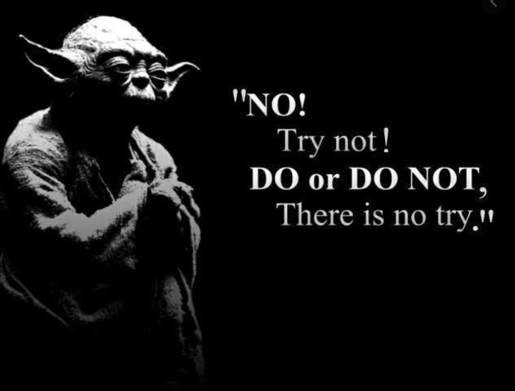

So his problem-solving skills shaped my problem-solving skills, which in turn have shaped others’ problem-solving skills.
I think that’s how a community works. It doesn’t have to be formal, organized, or planned. It just has to be human to human. The objective is to share knowledge, which means sharing your failures and what you learned from them. No one sees you fail on social media, but that’s not the reality. And it’s not helpful to others. It’s in the failure where the learning happens, and others can learn from your failures too, but only if you share them.
A Beginner's Mindset
Think back to when you learned something new for the first time, for example, doing a back squat. You likely had many questions:
Where does the bar go?
Where should your feet be?
What do you do with your hands?
How low is “below parallel”? (Along with the feeling that it is much lower than you thought it was)
But now, after having done back squats for a while, you don’t put as much thought into those things, and you do them automatically. The key point here is that once you are no longer a beginner, you forget what it was like initially. This comes into play when trying to share an experience with someone for the first time: you’ve forgotten what it looks like from their point of view and, as a result, skip over things foreign to them.
I’ve created hundreds of videos teaching people how to write code. One of the things that made those videos successful was capturing that beginner’s mindset. The scripts for many of my videos were written as I learned that particular coding language for the first time, resulting in capturing the questions I had as a beginner. Doing so made sure that I answered the questions a beginner would have long after I had forgotten those were questions.
This same technique applies to you too. As you interact and share your knowledge, experiences, and lessons in your community, try remembering what it was like as a beginner. When sharing your knowledge, active listening can reveal questions that may go unasked. Active listening is the act of discerning the difference between “what was asked” and “what was really meant to be asked.” For example, I work with clients to build new software frequently. Most of my clients have an idea and have thought about it a lot. The result is that they no longer have the beginner’s mindset, even for their own product. So my job is to quickly build the “thing they asked for” to determine “what they really meant to ask for.”
The first goal of answering a question is to determine what they really meant to ask.
Another approach to solving the beginner’s mindset is to start from the ground up. Guardian Training & Consulting does a great job of this. If you’ve ever taken one of their courses, you’ve experienced it firsthand. This approach involves starting at the ground and working your way up through every body part until you’ve completed the full motion. For example, start at the feet: where do they belong? Knees? Hips? Chest? Shoulder? Etc…. by the time you make it to the head, you’ve established the starting point; now, focus on moving the body parts corresponding to the desired outcome.
Because at some point, someone will look to you as the expert. Oddly, when this happens, you will not feel like the expert.
But here we are.
Remember the beginner’s mindset and apply the techniques learned here to share what you know. An expert is not someone who knows everything about a given topic. It’s someone who knows more than the person looking for help or advice.
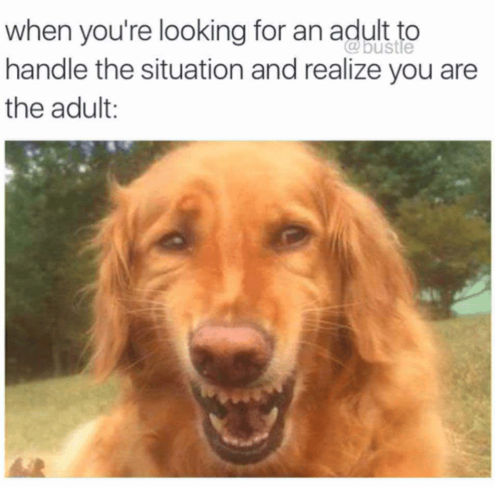

Dealing With Conflict
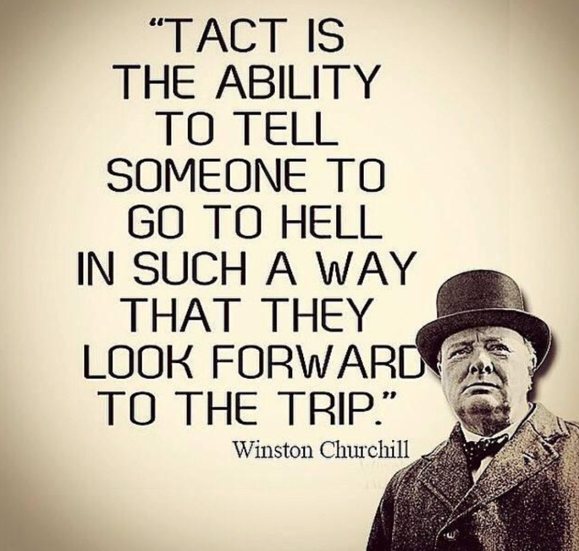

In Utopian societies, there is no need for conflict resolution. It may surprise you that we aren’t in one of those societies (hint: they don’t exist). With that little insightful chunk of knowledge, it’s logical to assume that we will have to deal with conflict at some point. Just as we train our bodies to overcome physical obstacles, we can also train our minds to overcome conflicts. Ultimately, all conflicts are resolved, sometimes peacefully or sometimes not.
It’s Not Personal
Ok, maybe it is personal. At least the opportunity to take it personally exists. But you don’t have to exercise that opportunity. You can let it pass. Marcus Aurelius said “choose not to be harmed, and you won’t feel harmed. Don’t feel harmed, and you haven’t been.” Put into a different perspective, ask yourself ” Have I ever said something hurtful that I wish I hadn’t?" I know I have, and in reflecting on it later, it’s common that I was reacting to a situation and took that frustration out on a person rather than the inanimate source of the problem. Taking this perspective helps to focus on the things you can control and let go of the ones you can’t.
One of my favorite quotes (though I can’t remember the author) about someone saying something bad about me is “had they really known me, they would have listed my other faults as well.”
Introducing Change
One common goal of resolving conflicts is to change the behavior of the conflicting party. Over time, I have learned that you will rarely be successful in this effort by pointing out someone’s negative behaviors. No one likes to be told they are wrong.
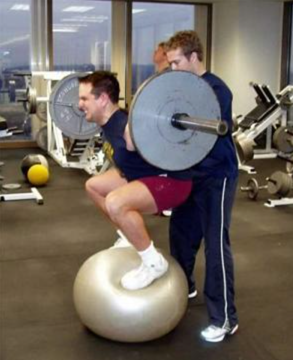

Sometimes you really feel like you should say something, though. How you approach it may determine the level of success you have. Your relationship with that person has a significant impact on this. One of the most valuable learnings I got from my time as a CrossFit coach was in communication. As a coach, you have to intervene and correct someone’s behavior at a time when they are under a substantial amount of stress. Most of the time, they are reluctant to change, focusing instead on whatever seems to be the fastest path to eliminating their stress (i.e., implementing poor form on a squat to get through the reps and finish the wod) regardless of the consequences they may not see.
If you want to communicate with someone successfully, you must do it in their language. Some people respond to visual cues, others to audible, and some tactile cues. In addition to their language, you have to learn the tone of communication for that person. Some people like to be coached, and others like to be told.
Common to all people, however, is that no one likes to be told they are wrong. A great way to introduce change is to ask someone “So, how’s that working for you?” It can be insightful as they provide their perspective and tell you what is important to them. They’ll also use words like “feels like…” (a tactile person) or “I see…” (a visual person). Capturing and using these phrases with the person will set you up for success by communicating in their language.
Another successful tactic I use for introducing change is “the billboard method.” Socrates was a master of this. Rather than arguing with you, he would ask questions, forcing you to run the gauntlet of your thoughts until you identified the flaw in your own logic. Instead of telling someone they are wrong, take them on a verbal “walk” where you paint a picture of the scenario unfolding right up to the point where their actions or behavior creates the obstacle. When the person “sees the billboard,” it becomes their idea, and they change their behavior (because they think they’ve stumbled onto a great idea).
And in the end, that’s what matters, right? Not that you were right and get credit for the idea, but that the desired change has been implemented.




































